List of popes
This chronological list of popes corresponds to that given in the Annuario Pontificio under the heading "I Sommi Pontefici Romani" (The Supreme Pontiffs of Rome), excluding those that are explicitly indicated as antipopes. Published every year by the Roman Curia, the Annuario Pontificio no longer identifies popes by regnal number, stating that it is impossible to decide which pope represented the legitimate succession at various times.[1] The 2001 edition of the Annuario Pontificio introduced "almost 200 corrections to its existing biographies of the popes, from St Peter to John Paul II". The corrections concerned dates, especially in the first two centuries, birthplaces and the family name of one pope.[2]
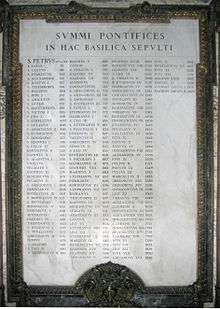
The term pope (Latin: papa, lit. 'father') is used in several churches to denote their high spiritual leaders (for example Coptic pope). This title in English usage usually refers to the head of the Catholic Church. The Catholic pope uses various titles by tradition, including Summus Pontifex, Pontifex Maximus, and Servus servorum Dei. Each title has been added by unique historical events and unlike other papal prerogatives, is not incapable of modification.[3]
Hermannus Contractus may have been the first historian to number the popes continuously. His list ends in 1049 with Leo IX as number 154. Several changes were made to the list during the 20th century. Christopher was considered a legitimate pope for a long time. Pope-elect Stephen was listed as Stephen II until the 1961 edition, when his name was removed. The decisions of the Council of Pisa (1409) were reversed in 1963 in a reinterpretation of the Western Schism, extending Gregory XII's pontificate to 1415 and classifying rival claimants Alexander V and John XXIII as antipopes.
A significant number of these popes have been recognized as saints, including 48 out of the first 50 consecutive popes, and others are in the sainthood process. Of the first 31 popes, 28 died as martyrs (see List of murdered popes).
Chronological list of popes
1st millennium
1st century
| Pontiff number |
Pontificate | Name: English · Latin |
Place of birth | Age at start/ end of papacy |
Notes |
|---|---|---|---|---|---|
| 1 | 30–33 – 64–68 | St Peter Sanctus PETRVS |
AD 1 Bethsaida, Galilea, Roman Empire[birth 1] | 29–32 / 62–67 | Born Jewish. First pope. Apostle of Jesus. According to Catholic tradition he received the keys of the Kingdom of Heaven (Matthew 16:18–19). Feast day (Feast of Saints Peter and Paul) 29 June, (Chair of Saint Peter) 22 February. He is recognized by the Catholic Church as the first Bishop of Rome appointed by Christ. Also revered as saint in Eastern Christianity, with a feast day of 29 June.[4] St. Peter's Basilica in Vatican City is named after him. |
| 2 | 64–68 – 76–79 | St Linus LINVS |
10 AD Volterrae, Italia, Roman Empire[birth 2] | 54–58 / 66–69 | First Roman pope.[5] Feast day 23 September. Also revered as a saint in Eastern Christianity, with a feast day of 7 June. |
| 3 | 76–79 – 88–91 | St Anacletus (Cletus) ANACLETVS (CLETVS) |
25 AD Athenae, Achaea, Roman Empire[birth 3] | 51–54 / 63–66 | First Greek pope. Feast day 26 April. Once erroneously split into Cletus and Anacletus.[6] |
| 4 | 26 April 88 – 23 November 99 (11 years, 211 days) |
St Clement I CLEMENS |
c. 35 AD Roma, Italy, Roman Empire[birth 4] | 53 / 64 (†66) | Roman. Feast day 23 November. Issued 1 Clement which is said to be the basis of apostolic authority for the clergy. Also revered as a saint in Eastern Christianity, with a feast day of 25 November. He was martyred by being tied to an anchor and being thrown in the sea. |
| 5 | 23 November 99 – 27 October 105 (5 years, 338 days) |
St Evaristus EVARISTVS |
c. 30 AD Bethlehem, Iudaea, Roman Empire[birth 5] | 69 / 75 | Hellenized Jew. Said to have divided Rome into parishes, assigning a priest to each. Feast day of 26 October. |
2nd century
| Pontiff number |
Pontificate | Name: English · Latin |
Place of birth | Age at start/ end of papacy |
Notes |
|---|---|---|---|---|---|
| 6 | 27 October 105 – 3 May 115 (9 years, 188 days) |
St Alexander I ALEXANDER |
c. 75 AD Rome, Italia, Roman Empire[birth 4] | 30 / 40 | Roman. Inaugurated the custom of blessing houses with holy water. Also revered as a saint in Eastern Christianity, with a feast day of 18 March. |
| 7 | 3 May 115 – 3 April 125 (9 years, 335 days) |
St Sixtus I XYSTVS |
42 AD Rome, Italia, Roman Empire[birth 4] | 73 / 83 | Greek. Feast day of 6 April. Also revered as a saint in Eastern Christianity, with a feast day of 10 August. |
| 8 | 3 April 125 – 5 January 136 (10 years, 277 days) |
St Telesphorus TELESPHORVS |
c. 67 AD Terra Nova, Italy, Roman Empire | 58 / 69 | Greek. Feast day of 5 January. Also revered as a saint in Eastern Christianity, with a feast day of 22 February. Church Father St. Irenaeus called him a great martyr. |
| 9 | 5 January 136 – 11 January 140 (4 years, 6 days) |
St Hyginus HYGINVS |
c. 74 Athens, Achaea, Roman Empire[birth 3] | 58 / 62 | Greek. Tradition holds he was martyred; feast day 11 January. |
| 10 | 11 January 140 – 11 July 155 (15 years, 181 days) |
St Pius I PIVS |
c. 81 AD Aquileia, Italy, Roman Empire[birth 6] | 59 / 74 | Roman, brother of Hermas. Martyred by sword; feast day 11 July. Decreed that Easter should only be celebrated on a Sunday. |
| 11 | 11 July 155 – 20 April 166 (10 years, 283 days) |
St Anicetus ANICETVS |
c. 92 AD Emesa, Syria, Roman Empire[birth 7] | 63 / 74 | Hellenized Syrian; first Syrian pope. Tradition holds he was martyred; feast day 17 April. Decreed that priests are not allowed to have long hair. |
| 12 | 20 April 166 – 22 April 174 (8 years, 2 days) |
St Soter SOTERIVS |
c. 119 AD Fundi, Italia, Roman Empire[birth 6] | 46 / 55 | Greek. Tradition holds he was martyred; feast day 22 April. Declared that marriage was valid as a sacrament blessed by a priest; formally inaugurated Easter as an annual festival in Rome. |
| 13 | 22 April 174 – 26 May 189 (15 years, 34 days) |
St Eleutherius ELEVTHERIVS |
c. 130 AD Nicopolis, Epirus, Roman Empire[birth 8] | 45 / 59 | Greek. Tradition holds he was martyred; feast day 6 May. |
| 14 | 26 May 189 – 28 July 199 (10 years, 63 days) |
St Victor I VICTOR |
c. 155 AD Africa, Roman Empire[birth 9] | 34 / 44 | Roman Berber; first pope to have been born on the continent of Africa. Known for excommunicating Theodotus of Byzantium. Quartodecimanism controversy. |
| 15 | 28 July 199 – 20 December 217 (18 years, 145 days) |
St Zephyrinus ZEPHYRINVS |
c. 160 AD Rome, Italia, Roman Empire[birth 4] | 39 / 57 | Roman. Combated against the adoptionist heresies of the followers of Theodotus the Byzantium who were ruled by Theodotus and Asclepiodotus.
Although not physically martyred (murdered), he is called a martyr for the suffering he endured. |
| — | c. 199 – c. 200 (1 year, 0 days) |
Natalius NATALIVS |
Rome, Italia, Roman Empire[birth 4] | — | Roman. In opposition to pope Zephyrinus. Later reconciled (see above). |
3rd century
| Pontiff number |
Pontificate | Name: English · Latin |
Place of birth | Age at start/ end of papacy |
Notes |
|---|---|---|---|---|---|
| 16 | 20 December 217 – 14 October 222 (4 years, 298 days) |
St Callixtus I CALLIXTVS |
c. 155 AD Rome, Italia, Roman Empire[birth 4] | 62 / 67 | Greek. Martyred; feast day 14 October. |
| — | 217 – 235 (18 years, 0 days) |
St Hippolytus HIPPOLYTVS |
c. 170 AD Asia Minor, Roman Empire | 47 / 65 | Greek. In opposition to Callistus I, Urban I and Pontian. Later reconciled with Pontian (see below). |
| 17 | 14 October 222 – 23 May 230 (7 years, 221 days) |
St Urban I VRBANVS |
c. 175 AD Rome, Italia, Roman Empire[birth 4] | 47 / 55 | Roman. Also revered as a saint in Eastern Christianity, with a feast day of 25 May. |
| 18 | 21 August 230 – 28 September 235 (5 years, 38 days) |
St Pontian PONTIANVS |
c. 175 AD Rome, Italia, Roman Empire[birth 4] | 55 / 60 | Roman. First to abdicate after exile to Sardinia by Emperor Maximinus Thrax. The Liberian Catalogue records his death on 28 September 235, the earliest exact date in papal history.[8][9] |
| 19 | 21 November 235 – 3 January 236 (43 days) |
St Anterus ANTERVS |
c. 180 AD Petelia, Italy, Roman Empire | 55 / 56 | Greek. Feast day 3 January. Also revered as a saint in Eastern Christianity, with a feast day of 5 August. |
| 20 | 10 January 236 – 20 January 250 (14 years, 10 days) |
St Fabian FABIANVS |
c. 200 AD Rome, Italia, Roman Empire[birth 4] | 36 / 50 | Roman. Divided the communities of Rome into seven districts, each supervised by a deacon. Feast day 20 January. Also revered as a saint in Eastern Christianity, with a feast day of 5 August. |
| 21 | 6 March 251 – 25 June 253 (2 years, 111 days) |
St Cornelius CORNELIVS |
c. 180 AD Rome, Italia, Roman Empire[birth 4] | 71 / 73 | Roman. Died as a martyr through extreme hardship; feast day 16 September. |
| — | March 251 – 258 (7 years, 0 days) |
Novatian NOVATIANVS |
c. 200–20 AD Rome, Italia, Roman Empire[birth 4] | 31–51 / 38–58 | Roman. Founder of Novatianism. In opposition to Cornelius, Lucius I, Stephen I and Sixtus II. |
| 22 | 25 June 253 – 5 March 254 (253 days) |
St Lucius I LUCIVS |
c. 200 AD Rome, Italia, Roman Empire[birth 4] | 48 / 49 | Roman. Feast day 5 March. |
| 23 | 12 March 254 – 2 August 257 (3 years, 143 days) |
St Stephen I STEPHANVS |
c. 205 AD Rome, Italia, Roman Empire[birth 4] | 54 / 57 | Greek. Martyred by beheading; feast day 2 August. Also revered as a saint in Eastern Christianity, with the same feast day. |
| 24 | 30 August 257 – 6 August 258 (341 days) |
St Sixtus II XYSTVS Secundus |
c. 215 AD Athens, Achaea, Roman Empire[birth 3] | 42 / 43 | Greek. Martyred by beheading. Also revered as a saint in Eastern Christianity, with a feast day of 10 August. |
| 25 | 22 July 259 – 26 December 268 (9 years, 157 days) |
St Dionysius DIONYSIVS |
c. 200 AD Terra Nova, Italy, Roman Empire | 59 / 68 | Greek. Feast day 26 December. |
| 26 | 5 January 269 – 30 December 274 (5 years, 359 days) |
St Felix I FELIX |
c. 206 AD Rome, Italy Roman Empire[birth 4] | 63 / 68 | Roman. |
| 27 | 4 January 275 – 7 December 283 (8 years, 337 days) |
St Eutychian EVTYCHIANVS |
c. 240 AD Luna, Italy, Roman Empire (Now Luni, Italy) | 35 / 43 | Roman. |
| 28 | 17 December 283 – 22 April 296 (12 years, 127 days) |
St Caius CAIVS |
c. 245 AD Salona, Dalmatia, Roman Empire | 38 / 51 | Roman. Martyred by beheading (according to legend). Feast day 22 April. Also revered as a saint in Eastern Christianity, with a feast day of 11 August. |
| 29 | 30 June 296 – 26 April 304 (7 years, 301 days) |
St Marcellinus MARCELLINVS |
c. 250 AD Rome, Italy, Roman Empire[birth 4] | 46 / 54 | Roman. Feast day 26 April. Also revered as a saint in Eastern Christianity, with a feast day of 7 June. |
4th century
| Pontiff number |
Pontificate | Name: English · Latin |
Place of birth | Age at start/ end of papacy |
Notes |
|---|---|---|---|---|---|
| 30 | 27 May 308 – 16 January 309 (234 days) |
St Marcellus I MARCELLVS |
c. 255 AD Rome, Italy, Roman Empire[birth 4] | 53 / 54 | Roman. Banished from Rome under Maxentius (309). |
| 31 | 18 April 309 – 17 August 310 (1 year, 121 days) |
St Eusebius EVSEBIVS |
c. 255 AD Sardinia, Roman Empire | 54 / 54 (†55) | Greek. Banished by the emperor Maxentius, and died in exile. |
| 32 | 2 July 311 – 10 January 314 (2 years, 192 days) |
St Miltiades (Melchiades) MILTIADES |
c. 270 AD Africa, Roman Empire | 41 / 44 | Roman Berber. First pope after the end of the persecution of Christians through the Edict of Milan (313 AD) issued by Constantine the Great. Presided over the Lateran council of 313. |
| 33 | 31 January 314 – 31 December 335 (21 years, 334 days) |
St Sylvester I SILVESTER |
c. 285 AD Fanum Sancti Angeli de Scala, Apulia et Calabria, Roman Empire | 29 / 50 | Roman. Feast day 31 December. Also revered as a saint in Eastern Christianity, with a feast day of 2 January. First Council of Nicaea (325). Under him was built: the Archbasilica of Saint John Lateran, Santa Croce in Gerusalemme and Old St. Peter's Basilica. Stated to be the recipient of the Donation of Constantine, which was later shown to be a forgery. |
| 34 | 18 January 336 – 7 October 336 (263 days) |
St Mark MARCVS |
c. 290 AD Rome, Italy, Roman Empire | 46 / 46 | Roman. One of Mark's undertakings was to compile stories of the lives of martyrs and bishops before his time. There is some reason to believe he founded two churches in the area of Rome. One of them is still known to this day as the Church of San Marco, although it is greatly changed since his time. The other church was at the Catacomb of Balbina, a cemetery. Emperor Constantine gave gifts of land and furnishing for both buildings. Feast day 7 October. |
| 35 | 6 February 337 – 12 April 352 (15 years, 66 days) |
St Julius I IVLIVS |
c. 280 AD Rome, Italy, Roman Empire | 57 / 72 | Roman. He was involved in the Arian controversy. Credited with splitting the birth of Christ into two distinct celebrations: The Epiphany stayed on the traditional date, and the Nativity was added on 25 December. |
| 36 | 17 May 352 – 24 September 366 (14 years, 130 days) |
Liberius LIBERIVS |
c. 310 AD Rome, Italy, Roman Empire | 42 / 56 | Roman. Earliest pope not canonized by the Roman Catholic Church. Revered as a saint in Eastern Christianity, with a feast day of 27 August.[10] |
| — | 355 – 22 November 365 (10 years, 0 days) |
Felix II FELIX Secundus |
c. 300 AD Rome, Italy, Roman Empire | 55 / 65 | Roman. In opposition to Pope Liberius. Installed by Roman Emperor Constantius II. |
| 37 | 1 October 366 – 11 December 384 (18 years, 71 days) |
St Damasus I DAMASVS |
Damasus | c. 305 AD Egitania, Lusitania or Rome, Italy, Roman Empire | 60 / 78 |
| — | 1 October 366 – 16 November 367 (1 year, 46 days) |
Ursinus VRSINVS |
Rome, Italy, Roman Empire | — | Roman. In opposition to Damasus I. Banished to Gallia by Emperor Valentinian II after a war between two sects and died after 384. |
| 38 | 17 December 384 – 26 November 399 (14 years, 344 days) |
St Siricius SIRICIVS |
c. 334 AD Rome, Italy, Roman Empire | 50 / 65 | Roman. His famous letters—the earliest surviving texts of papal decretals—focus particularly on religious discipline and include decisions on baptism, consecration, ordination, penance, and continence. Siricius’ important decretal of 386 (written to Bishop Himerius of Tarragona), commanding celibacy for priests, was the first decree on this subject.[11] |
| 39 | 27 November 399 – 19 December 401 (2 years, 22 days) |
St Anastasius I ANASTASIVS |
c. 340 AD Rome, Italy, Roman Empire | 59 / 61 | Roman. Instructed priests to stand and bow their heads as they read from the Gospels. |
5th century
| Pontiff number |
Pontificate | Name: English · Latin |
Place of birth | Age at start/ end of papacy |
Notes |
|---|---|---|---|---|---|
| 40 | 21 December 401 – 12 March 417 (15 years, 81 days) |
St Innocent I INNOCENTIVS |
c. 378 AD Albanum, Latium et Campania, Roman Empire | 41 / 57 | Roman. Visigoth Sack of Rome (410) under Alaric I. |
| 41 | 18 March 417 – 26 December 418 (1 year, 283 days) |
St Zosimus ZOSIMVS |
c. 370 AD Messurga, Lucania et Bruttii, Roman Empire | 47 / 48 | Greek. |
| — | 27 December 418 – 3 April 419 (97 days) |
Eulalius EVLALIVS |
c. 350–80 AD Rome, Italy, Roman Empire | 68–38 / 69–39 (†72–42) | Roman. In opposition to Pope Boniface I. Elected on the eve of the election of Boniface, first benefited from the support of the emperor Honorius, but lost it quickly. Exiled in Campania, and died in 423. |
| 42 | 28 December 418 – 4 September 422 (3 years, 250 days) |
St Boniface I BONIFACIVS |
c. 377 AD Rome, Italy, Roman Empire | 43 / 47 | Roman. |
| 43 | 10 September 422 – 27 July 432 (9 years, 321 days) |
St Celestine I CAELESTINVS |
c. 380 AD Campania, Roman Empire | 42 / 52 | Roman. Also revered as a saint in Eastern Christianity, with a feast day of 8 April. |
| 44 | 31 July 432 – 18 August 440 (8 years, 18 days) |
St Sixtus III XYXTVS Tertius |
c. 390 AD Rome, Italy, Roman Empire | 42 / 50 | Roman. |
| 45 | 29 September 440 – 10 November 461 (21 years, 42 days) |
St Leo I (Leo the Great) LEO MAGNVS |
c. 390 AD Etruria, Italia, Roman Empire | 50 / 71 | Roman. Convinced Attila the Hun to turn back his invasion of Italy. Wrote the Tome which was instrumental in the Council of Chalcedon and in defining the hypostatic union. Feast day 10 November. Also revered as a saint in Eastern Christianity, with a feast day of 18 February. |
| 46 | 19 November 461 – 29 February 468 (6 years, 102 days) |
St Hilary HILARIVS |
c. 400 AD Sardinia, Italy, Western Roman Empire | 46 / 53 | Roman. |
| 47 | 3 March 468 – 10 March 483 (15 years, 7 days) |
St Simplicius SIMPLICIVS |
c. 430 AD Tibur, Italy, Western Roman Empire | 38 / 53 | Roman. Papacy during the collapse of the Western Roman Empire and subsequent overtaking of Rome and Italy in general by Odoacer. |
| 48 | 13 March 483 – 1 March 492 (8 years, 354 days) |
St Felix III FELIX Tertius |
c. 440 AD Rome, Italy, Western Roman Empire | 43 / 52 | Imperial Roman pope. Sometimes called Felix II. Great-great-grandfather of pope Gregory I. |
| 49 | 1 March 492 – 21 November 496 (4 years, 265 days) |
St Gelasius I GELASIVS |
c. 410 AD Mons Ferratus, Quinquegentiani, Africa, Western Roman Empire | 82 / 86 | Roman Berber; the last pope to have been born on the continent of Africa. The first pope called the "Vicar of Christ".[12] |
| 50 | 24 November 496 – 19 November 498 (1 year, 360 days) |
Anastasius II ANASTASIVS Secundus |
c. 445 AD Rome, Italy, Western Roman Empire | 51 / 53 | Greek. Tried to end the Acacian schism but it resulted in the Laurentian schism. |
| 51 | 22 November 498 – 19 July 514 (15 years, 239 days) |
St Symmachus SYMMACHVS |
c. 460 AD Sardinia, Italy, Western Roman Empire | 38 / 54 | Roman. |
| — | 22 November 498 – Aug 506/8 (7 years, 252 days) |
Laurence LAVRENTIVS |
c. 460 AD Rome, Italy, Western Roman Empire | 38 / 46 (†48) | Roman. In opposition to Symmachus. Elected on the same day as Symachus, King Theodoric settled in favor of his adversary. Took control of Rome in 501 and remained pope in fact until he died in 506/08. |
6th century
| Pontiff number |
Pontificate | Name: English · Latin |
Place of birth | Age at start/ end of papacy |
Notes |
|---|---|---|---|---|---|
| 52 | 20 July 514 – 6 August 523 (9 years, 17 days) |
St Hormisdas HORMISDAS |
c. 450 AD Frusino, Italy, Western Roman Empire | 64 / 73 | Roman. Father of Pope Silverius. Acacian schism. |
| 53 | 13 August 523 – 18 May 526 (2 years, 278 days) |
St John I IOANNES |
c. 470 AD Sena Iulia, Italy, Western Roman Empire | 53 / 56 | Roman. |
| 54 | 12 July 526 – 22 September 530 (4 years, 72 days) |
St Felix IV FELIX Quartus |
c. 490 AD Samnium, Kingdom of Odoacer | 36 / 40 | Roman. Sometimes called Felix III. Built Santi Cosma e Damiano. |
| 55 | 22 September 530 – 17 October 532 (2 years, 25 days) |
Boniface II BONIFACIVS Secundus |
c. 490 AD Rome, Kingdom of Odoacer | 40 / 42 | Ostrogoth; first Germanic pope. Changed the numbering of the years in the Julian Calendar from Ab Urbe Condita to Anno Domini. |
| — | 22 September 530 – 14 October 530 (22 days) |
Dioscore DIOSCORVS |
Alexandria, Aegyptus, Eastern Roman Empire | — | Greek. In opposition to Pope Boniface II. Candidate of the Byzantine party, elected by the majority of the cardinals and recognized by Constantinople, he died less than a month after his election. |
| 56 | 2 January 533 – 8 May 535 (2 years, 126 days) |
John II IOANNES Secundus |
c. 473 AD Rome, Western Roman Empire | 63 / 65 | Roman. First pope not to use his personal name, as it was associated with a Roman god, Mercury. |
| 57 | 13 May 535 – 22 April 536 (356 days) |
St Agapetus I AGAPETVS |
c. 490 AD Rome, Kingdom of Odoacer | 45 / 46 | Roman. Feast days 22 April and 20 September. Also revered as a saint in Eastern Christianity, with a feast day of 17 April. |
| 58 | 8 June 536 – 11 March 537 (276 days) |
St Silverius SILVERIVS |
c. 480 AD Cicanum, Ostrogothic Kingdom | 56 / 57 | Roman. Exiled; feast day 20 June, son of Hormisdas. |
| 59 | 29 March 537 – 7 June 555 (18 years, 70 days) |
Vigilius VIGILIVS |
c. 500 AD Rome, Kingdom of Odoacer | 37 / 55 | Roman. |
| 60 | 16 April 556 – 4 March 561 (4 years, 322 days) |
Pelagius I PELAGIVS |
c. 505 AD Rome, Ostrogothic Kingdom | 51 / 56 | Roman. Credited with the construction of the basilica of Santi Apostoli. |
| 61 | 17 July 561 – 13 July 574 (12 years, 361 days) |
John III IOANNES Tertius |
c. 520 AD Rome, Ostrogothic Kingdom | 41 / 54 | Roman. |
| 62 | 2 June 575 – 30 July 579 (4 years, 58 days) |
Benedict I BENEDICTVS |
c. 525 AD Rome, Ostrogothic Kingdom | 50 / 54 | Roman. |
| 63 | 26 November 579 – 7 February 590 (10 years, 73 days) |
Pelagius II PELAGIVS Secundus |
c. 520 AD Rome, Ostrogothic Kingdom | 59 / 70 | Romanized Ostrogoth. Ordered the construction of the Basilica di San Lorenzo fuori le Mura. |
| 64 | 3 September 590 – 12 March 604 (13 years, 191 days) |
St Gregory I (Gregory the Great) GREGORIVS MAGNVS |
c. 540 AD Rome, Eastern Roman Empire | 50 / 64 | Last imperial Roman Pope. Great-great-grandson of pope Felix III. The first formally to employ the titles Servus servorum Dei and Pontifex Maximus. Established the Gregorian chant. Feast day 3 September. Also revered as a saint in Eastern Christianity, with a feast day of 12 March. Known as "the Father of Christian Worship". Known as "St. Gregory the Dialogist" in Eastern Orthodoxy. |
7th century
| Pontiff number |
Pontificate | Name: English · Latin |
Place of birth | Age at start/ end of papacy |
Notes |
|---|---|---|---|---|---|
| 65 | 13 September 604 – 22 February 606 (1 year, 162 days) |
Sabinian SABINIANVS |
c. 530 AD Blera, Eastern Roman Empire | 74 / 76 | Roman. For the next two centuries the Roman popes were all controlled by the Byzantine Empire. |
| 66 | 19 February 607 – 12 November 607 (266 days) |
Boniface III BONIFACIVS Tertius |
c. 540 AD Rome, Eastern Roman Empire | 67 / 67 | Greek. |
| 67 | 15 September 608 – 8 May 615 (6 years, 235 days) |
St Boniface IV BONIFACIVS Quartus |
c. 550 AD Marsica, Eastern Roman Empire | 58 / 65 | Roman. First pope to bear the same name as his immediate predecessor. Member of the Order of Saint Benedict. |
| 68 | 13 November 615 – 8 November 618 (2 years, 360 days) |
St Adeodatus I ADEODATVS or DEVSDEDIT |
c. 570 AD Rome, Eastern Roman Empire | 55 / 58 | Roman. Sometimes called Deusdedit. The first pope to use lead seals on papal documents, which in time came to be called papal bulls. |
| 69 | 23 December 619 – 25 October 625 (5 years, 306 days) |
Boniface V BONIFACIVS Quintus |
c. 575 AD Neapolis, Eastern Roman Empire | 44 / 50 | Roman. |
| 70 | 27 October 625 – 12 October 638 (12 years, 350 days) |
Honorius I HONORIVS |
c. 585 AD Ceperanum, Campania, Eastern Roman Empire | 40 / 53 | Roman. Named a heretic and anathematized by the Third Council of Constantinople. (680) |
| 71 | 28 May 640 – 2 August 640 (66 days) |
Severinus SEVERINVS |
c. 585 AD Rome, Eastern Roman Empire | 55 / 55 | Roman. |
| 72 | 24 December 640 – 12 October 642 (1 year, 292 days) |
John IV IOANNES Quartus |
c. 587 AD Iadera, Dalmatia, Eastern Roman Empire | 40 / 42 | Roman. |
| 73 | 24 November 642 – 14 May 649 (6 years, 171 days) |
Theodore I THEODORVS |
c. 610 AD Hierosolyma, Eastern Roman Empire | 32 / 39 | Greek. The last pope from Palestine. Planned the Lateran Council of 649, but died before it could open. |
| 74 | 5 July 649 – 12 November 655 (6 years, 130 days) |
St Martin I MARTINVS |
c. 590 AD Near Tuder, Umbria, Eastern Roman Empire | 59 / 65 | Roman. Last pope recognized as a martyr. Feast day of 12 November. Also revered as a saint in Eastern Christianity, with a feast day of 14 April. |
| 75 | 10 August 654 – 2 June 657 (2 years, 296 days) |
St Eugene I EVGENIVS |
c. 615 AD Rome, Duchy of Rome (formally Eastern Roman Empire) |
39 / 42 | Roman. |
| 76 | 30 July 657 – 27 January 672 (14 years, 181 days) |
St Vitalian VITALIANVS |
c. 600 Signia, Duchy of Rome (formally Eastern Roman Empire) |
57 / 72 | Roman. |
| 77 | 11 April 672 – 17 June 676 (4 years, 67 days) |
Adeodatus II ADEODATVS Secundus |
c. 621 Rome, Duchy of Rome (formally Eastern Roman Empire) |
51 / 55 | Roman. Sometimes called Adeodatus, without a number, in reference to Adeodatus I sometimes being called Deusdedit. Member of the Order of Saint Benedict. |
| 78 | 2 November 676 – 11 April 678 (1 year, 160 days) |
Donus DONVS |
c. 610 Rome, Duchy of Rome (formally Eastern Roman Empire) |
66 / 68 | Roman. |
| 79 | 27 June 678 – 10 January 681 (2 years, 197 days) |
St Agatho AGATHO |
c. 577 Panormus, Sicily, Eastern Roman Empire | 101 / 104 | Greek. Also revered as a saint in Eastern Christianity, with a feast day of 20 February. |
| 80 | 17 August 682 – 3 July 683 (320 days) |
St Leo II LEO Secundus |
c. 611 Aydonum, Sicily, Eastern Roman Empire | 71 / 72 | Greek. Feast day 3 July. |
| 81 | 26 June 684 – 8 May 685 (316 days) |
St Benedict II BENEDICTVS Secundus |
c. 635 Rome, Duchy of Rome (formally Eastern Roman Empire) |
49 / 50 | Roman. Feast day 7 May. |
| 82 | 23 July 685 – 2 August 686 (1 year, 10 days) |
John V IOANNES Quintus |
c. 635 Antiochia, Syria, Eastern Roman Empire | 50 / 51 | Greek. |
| 83 | 21 October 686 – 21 September 687 (335 days) |
Conon CONON |
c. 630 Thracia, Eastern Roman Empire | 56 / 57 | Greek. |
| 84 | 15 December 687 – 8 September 701 (13 years, 267 days) |
St Sergius I SERGIVS |
c. 650 Palermo, Sicily, Eastern Roman Empire | 37 / 51 | Hellenized Syrian. Introduced the singing of the Lamb of God at mass.[12] |
8th century
| Pontiff number |
Pontificate | Portrait | Name: English · Latin |
Personal name | Place of birth | Age at start/ end of papacy |
Notes |
|---|---|---|---|---|---|---|---|
| 85 | 30 October 701 – 11 January 705 (3 years, 73 days) (1169) |
John VI IOANNES Sextus |
Ioannes | c. 650 Ephesus, Eastern Roman Empire | 46 / 50 | Greek. The only pope who came from Asia Minor. | |
| 86 | 1 March 705 – 18 October 707 (2 years, 231 days) (961) |
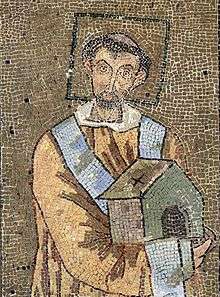 |
John VII IOANNES Septimus |
Ioannes | c. 655 Rossanum, Calabria, Eastern Roman Empire | 55 / 57 | Greek. The second pope to bear the same name as his immediate predecessor. |
| 87 | 15 January 708 – 4 February 708 (20 days) (20) |
Sisinnius SISINNIVS |
Sisinnius | c. 650 Syria, Rashidun Caliphate | 58 / 58 | Syrian. | |
| 88 | 25 March 708 – 9 April 715 (7 years, 15 days) (2571) |
Constantine CONSTANTINVS |
Constantinus | c. 664 Syria, Umayyad Caliphate | 44 / 51 | Syrian. Last pope to visit Greece while in office, until John Paul II in 2001. | |
| 89 | 19 May 715 – 11 February 731 (15 years, 268 days) (5747) |
St Gregory II GREGORIVS Secundus |
Gregorius | c. 669 Rome, Duchy of Rome (formally Eastern Roman Empire) |
46 / 62 | Roman. Feast day 11 February. Held the Synod of Rome (721). | |
| 90 | 18 March 731 – 28 November 741 (10 years, 255 days) (3908) |
St Gregory III GREGORIVS Tertius |
Gregorius | c. 669 Syria, Umayyad Caliphate | 41 / 51 | Syrian; the last pope from Syria. The third pope to bear the same name as his immediate predecessor. Was previously the last pope to have been born outside Europe until the election of Francis in 2013. | |
| 91 | 3 December 741 – 22 March 752 (10 years, 110 days) (3762) |
St Zachary ZACHARIAS |
Zacharias | c. 679 Sancta Severina, Calabria, Eastern Roman Empire | 62 / 73 | Greek. Feast day 15 March. Built the church of Santa Maria sopra Minerva. | |
| — | 22 March 752 – 25 March 752 (3) (Never took office as pope) |
Stephen STEPHANUS |
Stephanus | c. 700 Rome, Duchy of Rome (formally Eastern Roman Empire) |
52 / 52 | Roman. Previously known as Stephen II. Died three days after his election, having never received episcopal consecration. Some lists still include him. The Vatican sanctioned his addition in the sixteenth century; removed in 1961. He is no longer considered a pope by the Catholic Church. | |
| 92 | 26 March 752 – 26 April 757 (5 years, 31 days) (1857) |
Stephen II STEPHANVS Secundus |
Stephanus | c. 714 Rome, Duchy of Rome (formally Eastern Roman Empire) |
38 / 43 | Roman. Sometimes called Stephen III. The Donation of Pepin. Brother of Paul I. | |
| 93 | 29 May 757 – 28 June 767 (10 years, 30 days) (3682) |
St Paul I PAVLVS |
Paulus | c. 700 Rome, Duchy of Rome (formally Eastern Roman Empire) |
57 / 67 | Roman. Brother of Stephen II. | |
| 94 | 7 August 768 – 24 January 772 (3 years, 170 days) (1265) |
Stephen III STEPHANVS Tertius |
Stephanus | c. 723 Syracuse, Sicily, Eastern Roman Empire | 45 / 49 | Greek. Sometimes called Stephen IV. He summoned the Lateran Council (769). | |
| 95 | 1 February 772 – 26 December 795 (23 years, 328 days) (8729) |
Adrian I HADRIANVS |
Hadrianus | a. 700–12 Rome, Duchy of Rome (formally Eastern Roman Empire) |
72–60 / 95–83 | Roman. | |
| 96 | 26 December 795 – 12 June 816 (20 years, 169 days) (7474) |
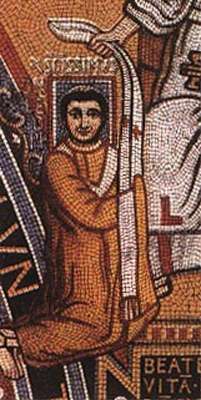 |
St Leo III LEO Tertius |
Leo | c. 750 Rome, Duchy of Rome (formally Eastern Roman Empire) |
45 / 66 | Roman. Crowned Charlemagne emperor on Christmas Day, 800, thereby initiating what would become the Holy Roman Empire, requiring the imprimatur of the pope for its ruler's legitimacy. |
9th century
| Pontiff number |
Pontificate | Name: English · Latin |
Place of birth | Age at start/ end of papacy |
Notes |
|---|---|---|---|---|---|
| 97 | 22 June 816 – 24 January 817 (216 days) (216) |
Stephen IV STEPHANVS Quartus |
c. 770 Rome, Papal States | 46 / 47 | First pope born in Rome after breaking away from the Roman Empire. Sometimes called Stephen V. |
| 98 | 25 January 817 – 11 February 824 (7 years, 17 days) (2573) |
St Paschal I PASCHALIS |
c. 775 Rome, Papal States | 42 / 49 | Italian. Son of Bonosus and Episcopa Theodora. Credited with finding the body of Saint Cecilia in the Catacomb of Callixtus, building the basilica of Santa Cecilia in Trastevere and the church of Santa Maria in Domnica. |
| 99 | 8 May 824 – 27 August 827 (3 years, 111 days) (1206) |
Eugene II EVGENIVS Secundus |
c. 780 Rome, Papal States | 44 / 47 | Italian. |
| 100 | 31 August 827 – 10 October 827 (40 days) (40) |
Valentine VALENTINVS |
c. 780 Rome, Papal States | 47 / 47 | Italian. |
| 101 | 20 December 827 – 25 January 844 (16 years, 36 days) (5880) |
Gregory IV GREGORIVS Quartus |
c. 790 Rome, Papal States | 37 / 54 | Italian. Rebuilt the atrium of St. Peter’s Basilica and in the newly decorated chapel transferred the body of Gregory I. |
| 102 | 25 January 844 – 27 January 847 (3 years, 2 days) (1098) |
Sergius II SERGIVS Secundus |
c. 790 Rome, Papal States | 54 / 57 | Italian. |
| 103 | 10 April 847 – 17 July 855 (8 years, 98 days) (3020) |
St Leo IV LEO Quartus |
c. 790 Rome, Papal States | 57 / 65 | Lombard. Member of the Order of Saint Benedict. |
| 104 | 29 September 855 – 17 April 858 (2 years, 200 days) (931) |
Benedict III BENEDICTVS Tertius |
c. 810 Rome, Papal States | 45 / 48 | Italian. |
| 105 | 24 April 858 – 13 November 867 (9 years, 203 days) (3490) |
St Nicholas I (Nicholas the Great) NICOLAVS MAGNVS |
c. 800 Rome, Papal States | 39 / 48 | Italian. Encouraged missionary activity. |
| 106 | 14 December 867 – 14 December 872 (5 years, 0 days) (1827) |
Adrian II HADRIANVS Secundus |
c. 792 Rome, Papal States | 75 / 80 | Italian. |
| 107 | 14 December 872 – 16 December 882 (10 years, 2 days) (3654) |
John VIII IOANNES Octavus |
c. 820 Rome, Papal States | 52 / 62 | Italian. First pope to be assassinated. |
| 108 | 16 December 882 – 15 May 884 (1 year, 151 days) (516) |
Marinus I MARINVS |
c. 830 Gallese, Papal States | 52 / 54 | Italian. Erroneously also known as Martin II. |
| 109 | 17 May 884 – 15 September 885 (1 year, 121 days) (486) |
St Adrian III HADRIANVS Tertius |
c. 830 Rome, Papal States | 49 / 50 | Italian. Feast day 8 July. Adrian I was possibly his ancestor. |
| 110 | 14 September 885 – 4 September 891 (5 years, 355 days) (2181) |
Stephen V STEPHANVS Quintus |
c. 840 Rome, Papal States | 45 / 51 | Italian. Sometimes called Stephen VI. |
| 111 | 6 October 891 – 4 April 896 (4 years, 181 days) (1642) |
Formosus FORMOSVS |
c. 805–16 Ostia, Papal States | 75–85 / 80–91 | Italian. In early 897 posthumously executed following the Cadaver Synod. His body was reburied with full Christian honors in 897. |
| 112 | 11 April 896 – 26 April 896 (15 days) (15) |
Boniface VI BONIFATIVS Sextus |
c. 806 Rome, Papal States | 90 / 90 | Italian. |
| 113 | 22 May 896 – 14 August 897 (1 year, 84 days) (449) |
Stephen VI STEPHANVS |
c. 850 Rome, Papal States | 46 / 47 | Italian. Sometimes called Stephen VII. Held the infamous Cadaver Synod. |
| 114 | 14 August 897 – Nov 897 (92 days) (92) |
Romanus ROMANVS |
c. 850 Gallese, Papal States | 47 / 47 | Italian. |
| 115 | December 897 – 20 December 897 (19 days) (19) |
Theodore II THEODORVS Secundus |
c. 840 Rome, Papal States | 57 / 57 | Greek. |
| 116 | 18 January 898 – 5 January 900 (1 year, 352 days) (717) |
John IX IOANNES Nonus |
c. 840 Tivoli, Papal States | 58 / 60 | Lombard. Member of the Order of Saint Benedict. |
| 117 | 1 February 900 – 30 July 903 (3 years, 179 days) (1274) |
Benedict IV BENEDICTVS Quartus |
c. 840 Rome, Papal States | 60 / 63 | Italian. |
10th century
| Pontiff number |
Pontificate | Name: English · Latin |
Place of birth | Age at start/ end of papacy |
Notes |
|---|---|---|---|---|---|
| 118 | 30 July 903 – Dec 903 (124 days) (124) |
Leo V LEO Quintus |
c. 845 Ardea, Papal States | 58 / 58 (†59) | Italian. Deposed and murdered. |
| — | October 903 – January 904 (92 days) (92) |
Christopher CHRISTOFORO |
Rome, Papal States | — | Italian. In opposition to Leo V. |
| 119 | 29 January 904 – 14 April 911 (7 years, 75 days) (2632) |
Sergius III SERGIVS Tertius |
c. 860 Rome, Papal States | 44 / 51 | Italian. "Saeculum obscurum" begins. The first pope to be depicted with the Papal Tiara. |
| 120 | 14 April 911 – June 913 (2 years, 48 days) (779) |
Anastasius III ANASTASIVS Tertius |
c. 865 Rome, Papal States | 46 / 48 | Italian. |
| 121 | 7 July 913 – 5 February 914 (213 days) (213) |
Lando LANDO |
c. 865 Sabina, Papal States | 48 / 49 | Italian. |
| 122 | March 914 – 28 May 928 (14 years, 88 days) (5202) |
John X IOANNES Decimus |
c. 860 Tossignano, Papal States | 54 / 68 | Italian. |
| 123 | 28 May 928 – Dec 928 (187 days) (187) |
Leo VI LEO Sextus |
c. 880 Rome, Papal States | 48 / 48 | Italian. |
| 124 | 3 February 929 – 13 February 931 (2 years, 10 days) (740) |
Stephen VII STEPHANVS Septimus |
c. 880 Rome, Papal States | 49 / 51 | Italian. Sometimes called Stephen VIII. |
| 125 | 15 March 931 – Dec 935 (4 years, 261 days) (1722) |
John XI IOANNES Undecimus |
c. 910 Rome, Papal States | 21 / 25 | Italian. Probably, according to the Liber Pontificalis and Liutprand of Cremona, the son of Pope Sergius III, and not of Alberic I of Spoleto, who was Marozia's husband. |
| 126 | 3 January 936 – 13 July 939 (3 years, 191 days) (1287) |
Leo VII LEO Septimus |
c. 885 Rome, Papal States | 41 / 44 | Italian. Member of the Order of Saint Benedict. |
| 127 | 14 July 939 – 30 October 942 (3 years, 108 days) (1204) |
Stephen VIII STEPHANVS Octavus |
c. 900 Rome, Papal States | 39 / 42 | Italian. Sometimes called Stephen IX. |
| 128 | 30 October 942 – 1 May 946 (3 years, 183 days) (1279) |
Marinus II MARINVS Secundus |
c. 900 Rome, Papal States | 42 / 46 | Italian. |
| 129 | 10 May 946 – 8 November 955 (9 years, 182 days) (3469) |
Agapetus II AGAPETVS Secundus |
c. 905 Rome, Papal States | 41 / 50 | Italian. |
| 130 | 16 December 955 – 6 December 963 (8 years, 356 days) (3278) |
John XII IOANNES Duodecimus |
c. 930–37 Rome, Papal States | 18–25 / 26–33 | Italian. Third pope not to use his personal name (Octavian). Deposed in 963 by Emperor Otto invalidly; end of the "Saeculum obscurum". |
| — | 6 December 963 – 26 February 964 (82 days) (82) |
Leo VIII LEO Octavus |
c. 915 Rome, Papal States | 48 / 49 | Italian. Appointed antipope by Emperor Otto in 963 in opposition to John XII and Benedict V. His pontificate after the deposition of Benedict V is considered legitimate by the modern Catholic Church. |
| 130 | 26 February 964 – 14 May 964 (78 days) (78) |
John XII IOANNES Duodecimus |
c. 937 Rome, Papal States | 27 / 27 | Italian. Murdered in 964. |
| 131 | 22 May 964 – 23 June 964 (32 days) (32) |
Benedict V BENEDICTVS Quintus |
c. 915 Rome, Papal States | 49 / 49 (†50) | Italian. Elected by the people of Rome, in opposition to Leo VIII who was appointed by Emperor Otto; he accepted his own deposition in 964 leaving Leo VIII as the sole pope. |
| 132 | 23 June 964 – 1 March 965 (251 days) (251) |
Leo VIII LEO Octavus |
c. 915 Rome, Papal States | 49 / 50 | Italian. His pontificate from 963 to 964 is considered illegitimate by today's Catholic Church. An appointee of Emperor Otto I, his pontificate occurred during the period known as the Saeculum obscurum. |
| 133 | 1 October 965 – 6 September 972 (6 years, 341 days) (2532) |
John XIII IOANNES Tertius Decimus |
c. 930 Rome, Papal States | 45 / 52 | Italian. Chronicled after his death as "the Good". |
| 134 | 19 January 973 – 8 June 974 (1 year, 140 days) (505) |
Benedict VI BENEDICTVS Sextus |
c. 925 Rome, Papal States | 48 / 49 | Lombard. Deposed and murdered. |
| — | July 974 – July 974 (30 days) (30) |
Boniface VII BONFATIUS Septinus |
Rome, Papal States | — | Italian, born Francone Ferucci. In opposition to Benedict VI and Benedict VII. |
| 135 | October 974 – 10 July 983 (8 years, 282 days) (3204) |
Benedict VII BENEDICTVS Septimus |
c. 930 Rome, Papal States | 44 / 53 | Italian. |
| 136 | December 983 – 20 August 984 (263 days) (263) |
John XIV IOANNES Quartus Decimus |
c. 940 Pavia, Kingdom of Italy, Holy Roman Empire | 43 / 44 | Italian. Fourth pope not to use his personal name (Pietro Canepanova). |
| — | 20 August 984 – 20 July 985 (334 days) (334) |
Boniface VII BONFATIUS Septinus |
Rome, Papal States | — | Italian. In opposition to John XIV and John XV |
| 137 | 20 August 985 – 1 April 996 (10 years, 225 days) (3877) |
John XV IOANNES Quintus Decimus |
c. 950 Rome, Papal States | 35 / 46 | Italian. The first pope to formally canonize a saint. |
| 138 | 3 May 996 – 18 February 999 (2 years, 291 days) (1021) |
Gregory V GREGORIVS Quintus |
c. 972 Stainach, Duchy of Carinthia, Holy Roman Empire | 24 / 27 | The first official German pope and fifth not to use his personal name (Bruno). Henceforth, this decision became tradition among future popes. |
| — | April 997 – February 998 (306 days) (306) |
John XVI IOANNES Sextus Decimus |
c. 941 Rossanum, Calabria, Italy, Eastern Roman Empire | 55 / 56 (†60) | Greek. In opposition to Gregory V |
| 139 | 2 April 999 – 12 May 1003 (4 years, 40 days) (1500) |
Sylvester II SILVESTER Secundus |
c. 940–42 Belliac, France | 52–54 / 56–58 | Born Gerbert, the first French (Occitan) pope. |
2nd millennium
11th century
| Pontiff number |
Pontificate | Portrait | Name: English · Latin |
Personal name | Place of birth | Age at start/ end of papacy |
Notes |
|---|---|---|---|---|---|---|---|
| 140 | 16 May 1003 – 6 November 1003 (174 days) |
John XVII IOANNES Septimus Decimus |
Siccone Secchi | c. 955 Rome, Papal States | 48 / 48 | Italian. | |
| 141 | 25 December 1003 – 18 July 1009 (5 years, 205 days) |
John XVIII IOANNES Duodevicesimus |
Giovanni Fasano | c. 965 Rapagnano, Papal States |
43 / 49 | Italian. | |
| 142 | 31 July 1009 – 12 May 1012 (2 years, 286 days) |
Sergius IV SERGIVS Quartus |
Pietro Martino Boccadiporco O.S.B. |
c. 970 Rome, Papal States | 39 / 42 | Italian. | |
| — | 12 June 1012 – 31 December 1012 (202 days) |
Gregory VI GREGORIVS Sextus |
Gregorio | Rome, Papal States | — | Italian. In opposition to Benedict VIII | |
| 143 | 18 May 1012 – 9 April 1024 (11 years, 327 days) |
Benedict VIII BENEDICTVS Octavus |
Teofilatto di Tuscolo | c. 980 Rome, Papal States | 32 / 44 | Italian. | |
| 144 | 14 May 1024 – 6 October 1032 (8 years, 145 days) |
John XIX IOANNES Undevicesimus |
Romano di Tuscolo | c. 975 Rome, Papal States | 49 / 57 | Italian. Brother of Benedict VIII. | |
| 145 | 21 October 1032 – 31 December 1044 (12 years, 71 days) |
Benedict IX BENEDICTVS Nonus |
Teofilatto di Tuscolo | Rome, Papal States | 20 / 32 (†43) | Italian; first term. | |
| 146 | 13 January 1045 – 10 March 1045 (56 days) |
Sylvester III SILVESTER Tertius |
Giovanni dei Crescenzi Ottaviani | c. 1000 Rome, Papal States | 45 / 45 (†63) | Italian. Validity of election questioned; considered antipope; deposed at the Council of Sutri. | |
| 147 | 10 March 1045 – 1 May 1045 (52 days) |
Benedict IX BENEDICTVS Nonus |
Teofilatto di Tuscolo | Rome, Papal States | 33 / 33 (†43) | Italian. Second term; deposed at the Council of Sutri. | |
| 148 | 5 May 1045 – 20 December 1046 (1 year, 229 days) |
Gregory VI GREGORIVS Sextus |
Giovanni Graziano Pierleoni | c. 1000 Rome, Papal States | 45 / 46 (†48) | Italian. Deposed at the Council of Sutri. | |
| 149 | 24 December 1046 – 9 October 1047 (289 days) |
Clement II CLEMENS Secundus |
Suidger von Morsleben-Hornburg | c. 967 Hornburg, Duchy of Saxony, Holy Roman Empire | 79 / 80 | German. Appointed by King Henry III at the Council of Sutri; crowned Henry III as emperor. | |
| 150 | 8 November 1047 – 17 July 1048 (252 days) |
Benedict IX BENEDICTVS Nonus |
Teofilatto di Tuscolo | 1012 Rome, Papal States | 35 / 36 (†43) | Italian. Third term; deposed and excommunicated. | |
| 151 | 17 July 1048 – 9 August 1048 (23 days) |
Damasus II DAMASVS Secundus |
Poppo de Curagnoni | c. 1000 Pildenau, Duchy of Bavaria, Holy Roman Empire | 48 / 48 | German. | |
| 152 | 12 February 1049 – 19 April 1054 (5 years, 66 days) |
.jpg) |
St Leo IX LEO Nonus |
Bruno von Egisheim-Dagsburg | 21 July 1002 Eguisheim, Duchy of Swabia, Holy Roman Empire | 47 / 51 | German. In 1054, mutual excommunications of Leo IX and Patriarch of Constantinople Michael I Cerularius began the East–West Schism. The anathematizations were rescinded by Pope Paul VI and Patriarch Athenagoras in 1965.[13] |
| 153 | 13 April 1055 – 28 July 1057 (2 years, 106 days) |
Victor II VICTOR Secundus |
Gebhard II von Calw-Dollnstein-Hirschberg | c. 1018 Duchy of Swabia, Holy Roman Empire | 37 / 39 | German. | |
| 154 | 2 August 1057 – 29 March 1058 (239 days) |
Stephen IX STEPHANVS Nonus (Decimus) |
Frederich O.S.B. |
c. 1020 Duchy of Lorraine, Holy Roman Empire | 37 / 38 | German. Sometimes called Stephen X. Member of the Order of Saint Benedict. | |
| — | 4 April 1058 – 24 January 1059 (295 days) |
Benedict X BENEDICTVS Decimus |
Giovanni Mincio di Tuscolo | Rome, Papal States | — | Italian. In opposition to Nicholas II. | |
| 155 | 6 December 1058 – 27 July 1061 (2 years, 233 days) |
 |
Nicholas II NICOLAVS Secundus |
Gerald de Bourgogne | c. 980 Château de Chevron, County of Savoy, Holy Roman Empire | 78 / 81 | French. In 1059 the College of Cardinals was designated the sole body of pope electors in the document In nomine Domini. (Papal conclave). |
| — | 30 September 1061 – 1072 (10 years, 185 days) |
Honorius II HONORIVS Secundus |
Pietro Candalus | 1010 Verona, Holy Roman Empire | 61 / 72 | Italian. In opposition to Pope Alexander II | |
| 156 | 30 September 1061 – 21 April 1073 (11 years, 203 days) |
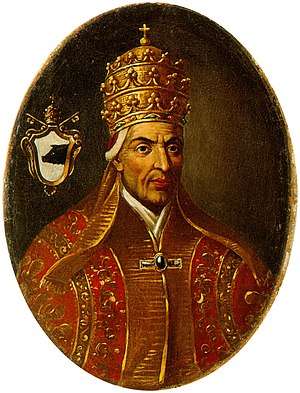 |
Alexander II ALEXANDER Secundus |
Anselmo da Baggio | c. 1018 Baggio, Milan, Holy Roman Empire | 46 / 58 | Italian. Authorised the Norman conquest of England in 1066. |
| 157 | 22 April 1073 – 25 May 1085 (12 years, 33 days) |
.jpg) |
St Gregory VII GREGORIVS Septimus |
Ildebrando Aldobrandeschi di Soana O.S.B. |
c. 1015 Sovana, March of Tuscany, Holy Roman Empire | 48 / 60 | Lombard. Initiated the Gregorian Reforms. Restricted the use of the papal title to the bishop of Rome.[4] Member of the Order of Saint Benedict. Political struggle with Emperor Henry IV, who had to go to Canossa (1077). |
| — | 25 June 1080 – 8 September 1100 (20 years, 75 days) |
Clement III CLEMENS Tertius |
Pietro Cadnalus | 1010 Verona, Holy Roman Empire | 61 / 72 | Italian. In opposition to Pope Gregory VII, Pope Victor III, Pope Urban II and Pope Paschal II. | |
| 158 | 24 May 1086 – 16 September 1087 (1 year, 115 days) |
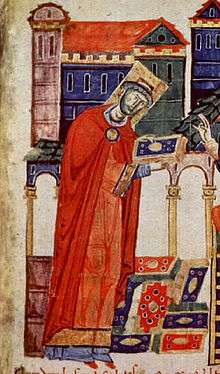 |
Bl. Victor III VICTOR Tertius |
Dauferio Epifani Del Zotto O.S.B. |
c. 1026 Benevento, Duchy of Benevento | 60 / 61 | Lombard. Member of the Order of Saint Benedict. Called the Synod of Benevento (1087) condemning lay investiture. |
| 159 | 12 March 1088 – 29 July 1099 (11 years, 139 days) |
Bl. Urban II VRBANVS Secundus |
Odon de Lagery O.S.B. |
c. 1042 Châtillon-sur-Marne, County of Champagne, France | 46 / 57 | French. Preached and started the First Crusade. Member of the Order of Saint Benedict. | |
| 160 | 13 August 1099 – 21 January 1118 (18 years, 161 days) |
Paschal II PASCHALIS Secundus |
Rainero Ranieri O.S.B. |
c. 1050 Bleda, March of Tuscany, Holy Roman Empire | 49 / 68 | Lombard. Member of the Order of Saint Benedict. Ordered the building of the basilica of Santi Quattro Coronati. | |
| — | 8 September 1100 – January 1101 (115 days) |
Theodoric THEODORICVS |
Teodorico | c. 1030 Rome, Papal States | 70 / 71 | Lombard. In opposition to Pope Paschal II |
12th century
| Pontiff number |
Pontificate | Portrait | Name: English · Latin |
Personal name | Place of birth | Age at start/ end of papacy |
Notes |
|---|---|---|---|---|---|---|---|
| — | January 1101 – February 1102 (1 year, 31 days) |
Adalbert ADALBERTVS |
Adalberto O.S.B. |
Rome, Papal States | — | Lombard. In opposition to Pope Paschal II | |
| — | 8 November 1105 – 11 April 1111 (5 years, 154 days) |
Sylvester IV SILVESTER Quartus |
Maguinulf | 1050 Rome, Papal States | 49 / 55 (†56) | German. In opposition to Paschal II. | |
| 161 | 24 January 1118 – 29 January 1119 (1 year, 5 days) |
Gelasius II GELASIVS Secundus |
Giovanni Caetani O.S.B. |
c. 1061 Gaeta, Duchy of Gaeta | 57 / 58 | Italian. | |
| — |
10 March 1118 – 20 April 1121 (3 years, 41 days) |
Gregory VIII GREGORIVS Octavus |
Maurice Baurdain | c. 1060 Limousin, Occitania, France | 58 / 61 (†77) | French (Occitan). In opposition to Gelasius II and Callixtus II. | |
| 162 | 2 February 1119 – 13 December 1124 (5 years, 315 days) |
 |
Callixtus II CALLISTVS Secundus |
Guy | c. 1060 Quingey, Franche-Comté | 59 / 64 | French. Opened the First Council of the Lateran in 1123. |
| — |
16 December 1124– 16 December 1124 (0 days) |
Celestine II COELESTINVS Secundus |
Teobaldo Boccapecora | 1050 Rome, Papal States | 74 / 74 (†76) | French. In opposition to Honorius II. | |
| 163 | 21 December 1124 – 13 February 1130 (5 years, 54 days) |
Honorius II HONORIVS Secundus |
Lamberto Scannabecchi da Fiagnano Can.Reg. |
9 February 1060 Fiagnano, Romagna, Holy Roman Empire | 64 / 70 | Italian. Canon Regular of S. Maria di San Reno. Approved the new military order of the Knights Templar in 1128. | |
| 164 | 14 February 1130 – 24 September 1143 (13 years, 222 days) |
.jpg) |
Innocent II INNOCENTIVS Secundus |
Gregorio Papareschi Can.Reg. |
c. 1082 Rome, Papal States | 48 / 61 | Italian. Canon regular of Lateran. Convened the Second Council of the Lateran, 1139. |
| — |
14 February 1130 – 25 January 1138 (7 years, 345 days) |
Anacletus II ANACLETUS Secundus |
Pietro Pierleoni O.S.B. |
1090 Rome, Papal States | 40 / 48 | Italian. In opposition to Innocent II. | |
| — |
23 March 1138 – 25 March 1138 (2 days) |
Victor IV VICTOR Quartus |
Gregorio Conti | Rome, Papal States | — | Italian. In Opposition to Pope Innocent II | |
| 165 | 26 September 1143 – 8 March 1144 (164 days) |
Celestine II COELESTINVS Secundus |
Guido Guelfuccio de Castello | c. 1085 Città di Castello, Papal States | 58 / 59 | Italian. | |
| 166 | 12 March 1144 – 15 February 1145 (340 days) |
Lucius II LUCIVS Secundus |
Gherardo Caccianemici dall'Orso Can.Reg. |
c. 1079 Bologna, Holy Roman Empire | 65 / 66 | Italian. Canon Regular of S. Frediano di Lucca. | |
| 167 | 15 February 1145 – 8 July 1153 (8 years, 143 days) |
Bl. Eugene III EVGENIVS Tertius |
Pietro dei Paganelli di Montemagno O.Cist.[14] |
c. 1080 Montemagno, Republic of Pisa | 44 / 52 | Italian. Member of the Order of Cistercians. Announced the Second Crusade. | |
| 168 | 12 July 1153 – 3 December 1154 (1 year, 144 days) |
Anastasius IV ANASTASIVS Quartus |
Corrado Demitri della Suburra | c. 1073 Rome, Papal States | 80 / 81 | Italian. | |
| 169 | 4 December 1154 – 1 September 1159 (4 years, 271 days) |
.png) |
Adrian IV HADRIANVS Quartus |
Nicholas Breakspear Can.Reg. |
c. 1100 Abbots Langley, Hertfordshire, Kingdom of England | 54 / 59 | The only English (Anglo-Saxon) pope; purportedly granted Ireland to Henry II, King of England. Canon Regular of St. Rufus Monastery. |
| 170 | 7 September 1159 – 30 August 1181 (21 years, 357 days) |
Alexander III ALEXANDER Tertius |
Rolando Bandinelli | c. 1100 Siena, Republic of Siena | 59 / 81 | Italian. Convened the Third Council of the Lateran, 1179. | |
| — |
7 September 1159 – 20 April 1164 (4 years, 226 days) |
Victor IV VICTOR Quartus |
Ottaviano dei Crescenzi Ottaviani di Monticelli | 1095 Rome, Papal States | 64 / 69 | Italian. In opposition to Pope Alexander III. | |
| — |
28 April 1164 – 22 September 1168 (4 years, 147 days) |
Paschal III PASCALIS Tertius |
Guido di Crema | 1110 Rome, Papal States | 54 / 58 | Italian. In opposition to Alexander III. | |
| — |
30 September 1168 – 29 August 1178 (9 years, 333 days) |
Callixtus III CALLIXTVS Tertius |
Giovanni di Struma O.S.B. |
1090 Rome, Papal States | 78 / 88 | Italian. In opposition to Alexander III. | |
| — |
29 September 1179 – January 1180 (124 days) |
Innocent III INNOCENTIVS Tertius |
Lando di Sezze (or Lanzo) | 1120 Sezze, Papal States | 59 / 60 (†63) | Italian. In opposition to Alexander III. | |
| 171 | 1 September 1181 – 25 November 1185 (4 years, 85 days) |
Lucius III LUCIVS Tertius |
Ubaldo Allucignoli | c. 1097 Lucca, March of Tuscany, Holy Roman Empire | 84 / 88 | Italian. | |
| 172 | 25 November 1185 – 20 October 1187 (1 year, 329 days) |
Urban III VRBANVS Tertius |
Uberto Crivelli | c. 1120 Cuggiono, Holy Roman Empire | 67 / 67 | Italian. | |
| 173 | 21 October 1187 – 17 December 1187 (57 days) |
Gregory VIII GREGORIVS Octavus |
Alberto de Morra Can.Reg. |
c. 1100 Benevento, Papal States | 87 / 87 | Italian. Canon Regular Premostratense. Proposed the Third Crusade. | |
| 174 | 19 December 1187 – 20 March 1191[15] (3 years, 91 days) |
Clement III CLEMENS Tertius |
Paolo Scolari | c. 1130 Rome, Papal States | 57 / 61 | Italian. | |
| 175 | 30 March 1191 – 8 January 1198 (6 years, 284 days) |
.png) |
Celestine III COELESTINVS Tertius |
Giacinto Bobone Orsini | c. 1106 Rome, Papal States | 85 / 92 | Motto: Perfice gressus meos in semitis tuis ("Going in Thy path") Italian. |
| 176 | 8 January 1198 – 16 July 1216 (18 years, 190 days) |
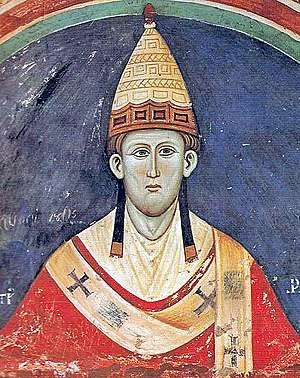 |
Innocent III INNOCENTIVS Tertius |
Lotario dei Conti di Segni | 1161 Gavignano, Papal States | 37 / 55 | Italian. Convened the Fourth Council of the Lateran, 1215. Initiated the Fourth Crusade but later distanced himself from it and threatened participants with excommunication when it became clear that the leadership abandoned a focus on conquest of the Holy Land and instead intended to sack Christian cities.[16] Endorsed the Franciscan Order. |
13th century
| Pontiff number |
Pontificate | Portrait | Name: English · Latin |
Personal name | Place of birth | Age at start/ end of papacy |
Notes |
|---|---|---|---|---|---|---|---|
| 177 | 18 July 1216 – 18 March 1227 (10 years, 243 days) |
.jpg) |
Honorius III HONORIVS Tertius |
Cencio Savelli | c. 1148–50 Rome, Papal States | 66–68 / 77–79 | Italian. Initiated the Fifth Crusade. Approved several religious and tertiary orders. |
| 178 | 19 March 1227 – 22 August 1241 (14 years, 156 days) |
.jpg) |
Gregory IX GREGORIVS Nonus |
Ugolino dei Conti di Segni, O.F.S | c. 1145–70 Anagni, Papal States | 57–82 / 71–96 | Italian. Initiated the inquisition in France and endorsed the Northern Crusades. |
| 179 | 25 October 1241 – 10 November 1241 (16 days) |
Celestine IV COELESTINVS Quartus |
Goffredo Castiglioni | c. 1180–87 Milan, Italy, Holy Roman Empire | 54–61 / 54–61 | Italian. Died before coronation. | |
| 180 | 25 June 1243 – 7 December 1254 (11 years, 165 days) |
 |
Innocent IV INNOCENTIVS Quartus |
Sinibaldo Fieschi | c. 1195 Genoa, Republic of Genoa, Holy Roman Empire | 48 / 60 | Italian. Convened the First Council of Lyons (1245). Issued the bull Ad extirpanda that permitted the torture of heretics (1252). |
| 181 | 12 December 1254 – 25 May 1261 (6 years, 164 days) |
Alexander IV ALEXANDER Quartus |
Rinaldo dei Conti di Jenne | c. 1199 Jenne, Papal States | 55 / 62 | Italian. Established an Inquisition in France. | |
| 182 | 29 August 1261 – 2 October 1264 (3 years, 34 days) |
Urban IV VRBANVS Quartus |
Jacques Pantaléon | c. 1195 Troyes, County of Champagne, France | 66 / 69 | French. Instituted the feast of Corpus Christi (1264). | |
| 183 | 5 February 1265 – 29 November 1268 (3 years, 298 days) |
Clement IV CLEMENS Quartus |
Gui Faucoi | 23 November 1190 Saint-Gilles, Languedoc, France | 62 / 66 | French. | |
| — | 29 November 1268 – 1 September 1271 (2 years, 276 days) |
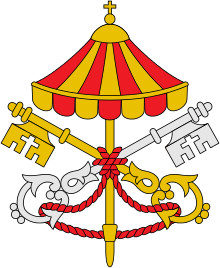 |
Interregnum | Almost three-year period without a valid pope elected. This was due to a deadlock among cardinals voting for the pope. | |||
| 184 | 1 September 1271 – 10 January 1276 (4 years, 131 days) |
Bl. Gregory X GREGORIVS Decimus |
Tebaldo Visconti, O.F.S | c. 1210 Piacenza, Italy, Holy Roman Empire | 51 / 66 | Italian. Convened the Second Council of Lyons (1274). Responsible for regulation all papal conclaves until the 20th century. | |
| 185 | 21 January 1276 – 22 June 1276 (153 days) |
Bl. Innocent V INNOCENTIVS Quintus |
Pierre de Tarentaise, O.P. | c. 1224/5 County of Savoy, Holy Roman Empire | 52 / 52 | French. Member of the Dominican Order. | |
| 186 | 11 July 1276 – 18 August 1276 (38 days) |
Adrian V HADRIANVS Quintus |
Ottobuono Fieschi | c. 1216 Genoa, Republic of Genoa, Holy Roman Empire | 60 / 60 | Italian. Annulled Gregory X's papal bull on the regulations of papal conclaves. | |
| 187 | 8 September 1276 – 20 May 1277 (254 days) |
John XXI IOANNES Vicesimus Primus |
Pedro Julião (a.k.a. Petrus Hispanus and Pedro Hispano) | c. 1215 Lisbon, Portugal | 60 / 70 | Portuguese. Due to a confusion over the numbering of popes named John in the 13th century, the ordinal XX was skipped. | |
| 188 | 25 November 1277 – 22 August 1280 (2 years, 271 days) |
Nicholas III NICOLAVS Tertius |
Giovanni Gaetano Orsini | c. 1216 Rome, Papal States | 61 / 64 | Italian. Planned the Sicilian Vespers. | |
| 189 | 22 February 1281 – 28 March 1285 (4 years, 34 days) |
Martin IV MARTINVS Quartus |
Simon de Brion | c. 1210 Meinpicien, Touraine, France | 71 / 75 | French. | |
| 190 | 2 April 1285 – 3 April 1287 (2 years, 1 day) |
Honorius IV HONORIVS Quartus |
Giacomo Savelli | c. 1210 Rome, Papal States | 75 / 77 | Italian. | |
| 191 | 22 February 1288 – 4 April 1292 (4 years, 42 days) |
Nicholas IV NICOLAVS Quartus |
Girolamo Masci, O.F.M. | 30 September 1227 Lisciano, Papal States | 60 / 64 | Italian. Member of the Franciscan Order. | |
| — | 4 April 1292 – 5 July 1294 (2 years, 92 days) |
 |
Interregnum | Two-year period without a valid pope elected. This was due to a deadlock among cardinals voting for the pope. | |||
| 192 | 5 July 1294 – 13 December 1294 (161 days) |
St Celestine V COELESTINVS Quintus |
Pietro Angelerio, O.S.B. | c. 1207–09 Sant'Angelo Limosano, Kingdom of Sicily | 85–87 / 85–87 (†87–89) | Italian. One of the few popes who abdicated voluntarily. Member of the Order of Saint Benedict. Founded the Celestines. Resigned from office and rumored to have been murdered in prison by Boniface VIII. | |
| 193 | 24 December 1294 – 11 October 1303 (8 years, 291 days) |
 |
Boniface VIII BONIFATIVS Octavus |
Benedetto Caetani | c. 1230–36 Anagni, Papal States | 59–64 / 68–73 | Italian. Formalized the Jubilee in 1300. Issued Unam Sanctam (1302) which proclaimed papal supremacy and pushing it to its historical extreme. |
14th century
| Pontiff number |
Pontificate | Portrait | Name: English · Latin |
Personal name | Place of birth | Age at start/ end of papacy |
Notes |
|---|---|---|---|---|---|---|---|
| 194 | 22 October 1303 – 7 July 1304 (259 days) |
Bl. Benedict XI BENEDICTVS Undecimus |
Niccolò Boccasini, O.P. | c. 1240 Treviso, Papal States | 63 / 64 | Motto: Illustra faciem Tuam super servum Tuum ("Let Your Face shine upon Your servant")
Italian. Member of the Dominican Order. Reverted Boniface VIII's Unam Sanctam. | |
| 195 | 5 June 1305 – 20 April 1314 (8 years, 319 days) |
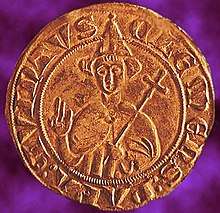 |
Clement V CLEMENS Quintus |
Raymond Bertrand de Gouth | c. 1264 Villandraut, Gascony, France | 41 / 50 | French. Pope at Avignon. Convened the Council of Vienne (1311–1312). Initiated the persecution of the Knights Templar with the bull Pastoralis Praeeminentiae under pressure from King Philip IV of France. |
| — | 20 April 1314 – 7 August 1316 (2 years, 79 days) |
 |
Interregnum | Two-year period without a valid pope elected. This was due to a deadlock among cardinals voting for the pope. | |||
| 196 | 7 August 1316 – 4 December 1334 (18 years, 119 days) |
John XXII IOANNES Vicesimus Secundus |
Jacques d'Euse; Jacques Duèse | c. 1244–49 Cahors, Quercy, France | 67–72 / 85–90 | French. Pope at Avignon. Controversial for his views on the Beatific Vision. | |
| — |
12 May 1328– 25 July 1330 (2 years, 74 days) |
Nicholas V NICOLAVS Quintus |
Pietro Rainalducci, O.F.M. |
1260 Corvaro, Papal States | 68 / 70 (†73) | Italian. In opposition to John XXII. | |
| 197 | 20 December 1334 – 25 April 1342 (7 years, 126 days) |
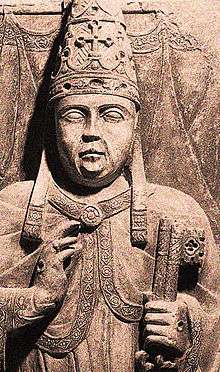 |
Benedict XII BENEDICTVS Duodecimus |
Jacques Fournier, O.Cist. | c. 1280–85 Saverdun, County of Foix, France | 49–54 / 57–62 | French. Pope at Avignon. Member of the Order of Cistercians. Known for issuing the Apostolic constitution Benedictus Deus (1336). |
| 198 | 7 May 1342 – 6 December 1352 (10 years, 213 days) |
.jpg) |
Clement VI CLEMENS Sextus |
Pierre Roger, O.S.B. | c. 1291 Maumont, Limousin, France | 51 / 61 | French. Pope at Avignon. Reigned during the Black Death and absolved those who died of it of their sins. |
| 199 | 18 December 1352 – 12 September 1362 (9 years, 268 days) |
Innocent VI INNOCENTIVS Sextus |
Étienne Aubert | c. 1282 Les Monts, Limousin, France | 70 / 80 | French. Pope at Avignon. Through his exertions the Treaty of Brétigny (1360) was brought about. | |
| 200 | 28 September 1362 – 19 December 1370 (8 years, 82 days) |
.jpg) |
Bl. Urban V VRBANVS Quintus |
Guillaume (de) Grimoard, O.S.B. | c. 1309–10 Grizac, Languedoc, France | 52–53 / 60–61 | French. Pope at Avignon. Member of the Order of Saint Benedict. Reformed areas of education and sent missionary movements across Europe and Asia. His pontificate witnessed the Alexandrian and Savoyard crusades. |
| 201 | 30 December 1370 – 27 March 1378 (7 years, 87 days) |
.png) |
Gregory XI GREGORIVS Undecimus |
Pierre Roger de Beaufort | c. 1329 Maumont, Limousin, France | 41 / 49 | French. Pope at Avignon; returns to Rome. The last French pope. |
| 202 | 8 April 1378 – 15 October 1389 (11 years, 190 days) |
.png) |
Urban VI VRBANVS Sextus |
Bartolomeo Prignano | c. 1318 Naples, Kingdom of Naples | 60 / 71 | Italian. Western Schism. Last pontiff to be elected outside the College of Cardinals. |
| — | 20 September 1378 – 16 September 1394 (15 years, 353 days) |
Clement VII CLEMENS Septimus |
Robert de Genève | 1342 Chateau d'Annecy, County of Savoy, H.R.E. | 36 / 52 | French. In opposition to Urban VI (1378–89) and Boniface IX (1389–1404) | |
| — |
28 September 1394 – 23 May 1423 (28 years, 237 days) |
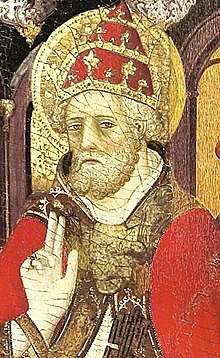 |
Benedict XIII BENEDICTVS Tertius Decimus |
Pedro Martínez de Luna y Pérez de Gotor | 25 November 1328 Illueca, Aragon | 66 / 94 | Spanish. In opposition to Boniface IX (1389–1404), Innocent VII (1404–06), Gregory XII (1406–15), Martin V (1417–31) and Pisan Antipopes Alexander V (1409–10) and John XXIII (1410–15) |
| 203 | 2 November 1389 – 1 October 1404 (14 years, 334 days) |
Boniface IX BONIFATIVS Nonus |
Pietro Tomacelli Cybo | c. 1348–50 Naples, Kingdom of Naples | c. 39-41 / c. 54-56 | Italian of Greek descent. Western Schism. | |
15th century
| Pontiff number |
Pontificate | Portrait | Name: English · Latin |
Personal name | Place of birth | Age at start/ end of papacy |
Notes |
|---|---|---|---|---|---|---|---|
| 204 | 17 October 1404 – 6 November 1406 (2 years, 20 days) |
Innocent VII INNOCENTIVS Septimus |
Cosimo Gentile Migliorati | 1336–39 Sulmona, Kingdom of Naples | 65–68 / 67–71[B] | Italian. Reigned during the Western Schism. | |
| 205 | 30 November 1406 – 4 July 1415 (8 years, 216 days) |
Gregory XII GREGORIVS Duodecimus |
Angelo Correr | 14 May 1324 Venice, Republic of Venice | 82 / 91 (†91) | Italian. Reigned during the Western Schism. | |
| — |
30 June 1409 – 3 May 1410 (307 days) |
Alexander V ALEXANDER Quintus |
Pétros Philárgēs, O.F.M. |
1339 Candia Lomellina, Lombardy, Duchy of Milan | 70 / 71 | Greek. Western Schism. In opposition to Gregory XII. Considered a legitimate pope until 1963 and is numbered as such to this day. | |
| — |
25 May 1410 – 30 May 1415 (5 years, 5 days) |
John XXIII IOANNES Vicesimus Tertius |
Baldassarre Cossa | 1365 Procida, Naples | 45 / 50 (†54) | Italian. Western Schism. In opposition to Gregory XII. Convened Council of Constance. Abdicated. Became dean of the College of Cardinals in 1417. Was considered a legitimate pope until 1958. | |
| — | 4 July 1415 – 11 November 1417 (2 years, 136 days) |
 |
Interregnum | Two-year period without a valid pope elected. The Council of Constance called on all three papal claimants to abdicate, but only Gregory XII (Roman) and John XXIII (Pisan) abdicated. The Council finally excommunicated Benedict XIII (Avignon) and elected a new pope. | |||
| 206 | 11 November 1417 – 20 February 1431 (13 years, 101 days) |
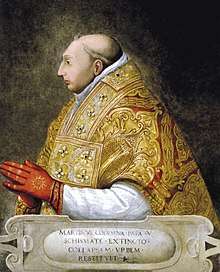 |
Martin V MARTINVS Quintus |
Oddone Colonna, O.F.S | Jan/Feb 1369 Genazzano, Papal States | 48 / 62 | Italian. Convened the Council of Basel (1431). Initiated the Hussite Wars. |
| — |
20 June 1423[17] (or 10 June 1423[18]) – 26 July 1429 (6 years, 36 days) |
Clement VIII CLEMENS Octavus |
Gil Sánchez Muñoz y Carbón | 1369 Teruel, Aragon | 54 / 60 (†77) | Italian. Western Schism. In opposition to Martin V. | |
| 207 | 3 March 1431 – 23 February 1447 (15 years, 357 days) |
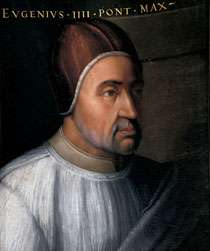 |
Eugene IV EVGENIVS Quartus |
Gabriele Condulmer, O.S.A. | 1383 Venice, Republic of Venice | 47 / 63[B] | Italian. Member of the Augustinian Order. Nephew of Gregory XII. Crowned Emperor Sigismund at Rome in 1433. Transferred the Council of Basel to Ferrara. It was later transferred again, to Florence, because of the Bubonic plague. |
| — |
5 November 1439 – 7 April 1449 (9 years, 153 days) |
Felix V FELIX Quintus |
Amadeus | 4 September 1383 Chambéry, France | 56 / 65 (†67) | French. In opposition to Eugene IV[19] and Nicholas V[20]. Also ruled as count of Savoy. | |
| 208 |
6 March 1447 – 24 March 1455 (8 years, 18 days) |
 |
Nicholas V NICOLAVS Quintus |
Tommaso Parentucelli, O.P. | 13 November 1397 Sarzana, Republic of Genoa | 49 / 57 | Italian. Member of the Dominican Order. Held the Jubilee of 1450. Crowned Emperor Frederick III at Rome (1452). Issued the bull Dum Diversas allowing Portugal's right to conquer and subjugate Saracens and pagans (1452). Created a library in the Vatican which would eventually become the Bibliotheca Apostolica Vaticana. |
| 209 |
8 April 1455 – 6 August 1458 (3 years, 120 days) |
.jpg) |
Callixtus III CALLISTVS Tertius |
Alfonso de Borja | 31 December 1378 Xàtiva, Kingdom of Valencia, Crown of Aragon | 76 / 79 | The first Spanish (Valencian) pope. Ordered the Feast of the Transfiguration to be celebrated on 6 August. Ordered the retrial of Joan of Arc, in which she was vindicated. |
| 210 |
19 August 1458 – 15 August 1464 (5 years, 362 days) |
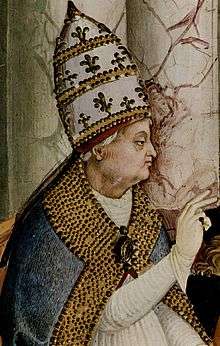 |
Pius II PIVS Secundus |
Enea Silvio Piccolomini | 18 October 1405 Corsignano, Republic of Siena | 52 / 58 | Italian. Displayed a great interest in urban planning. Founded Pienza near Siena as the ideal city in 1462. Known for his work on the Commentaries. |
| 211 | 30 August 1464 – 26 July 1471 (6 years, 330 days) |
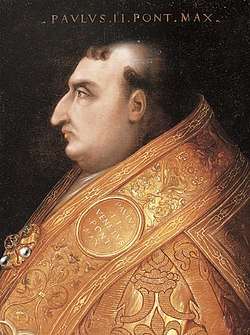 |
Paul II PAVLVS Secundus |
Pietro Barbo | 23 February 1417 Venice, Republic of Venice | 47 / 54 | Italian. The nephew of Eugene IV. Built the Palazzo San Marco (now Palazzo Venezia). Approved the introduction of printing in the Papal States. |
| 212 |
9 August 1471 – 12 August 1484 (13 years, 3 days) |
 |
Sixtus IV XYSTVS Quartus |
Francesco della Rovere, O.F.M. | 21 July 1414 Celle Ligure, Republic of Genoa | 57 / 70 | Italian. Member of the Franciscan Order. Commissioned the Sistine Chapel. Authorized an Inquisition targeting converted Jewish Christians in Spain at the request of the Catholic Monarchs of Spain. |
| 213 |
29 August 1484 – 25 July 1492 (7 years, 331 days) |
Innocent VIII INNOCENTIVS Octavus |
Giovanni Battista Cybo | 1432 Genoa, Republic of Genoa | 51 / 59[B] | Italian. Appointed Tomás de Torquemada. Endorsed the prosecution of witchcraft in the bull Summis desiderantes affectibus (1484). | |
| 214 |
11 August 1492 – 18 August 1503 (11 years, 7 days) |
 |
Alexander VI ALEXANDER Sextus |
Roderic Llançol i de Borja | 1 January 1431 Xàtiva, Kingdom of Valencia, Crown of Aragon | 61 / 72 | Spanish (Catalan); Nephew of Callixtus III; father to Cesare Borgia and Lucrezia Borgia. Divided the extra-European world between Spain and Portugal in the bull Inter caetera (1493). |
16th century
| Pontiff number |
Pontificate | Portrait | Name: English · Latin |
Personal name | Place of birth | Age at start/ end of papacy |
Notes |
|---|---|---|---|---|---|---|---|
| 215 |
22 September 1503 – 18 October 1503 (26 days) |
 |
Pius III PIVS Tertius |
Francesco Todeschini Piccolomini | 29 May 1439 Siena, Republic of Siena | 64 / 64 | Italian. Nephew of Pius II. Founded the Piccolomini Library in the Siena Cathedral. |
| 216 |
31 October 1503 – 21 February 1513 (9 years, 113 days) |
 |
Julius II IVLIVS Secundus |
Giuliano della Rovere, O.F.M. | 5 December 1443 Albisola, Republic of Genoa | 59 / 69 | Italian. Nephew of Sixtus IV; convened the Fifth Council of the Lateran (1512). Took control of all the Papal States for the first time. Commissioned Michelangelo to paint the Sistine Chapel ceiling. Commissioned the rebuilding of St Peter's Basilica. |
| 217 |
9 March 1513 – 1 December 1521 (8 years, 267 days) |
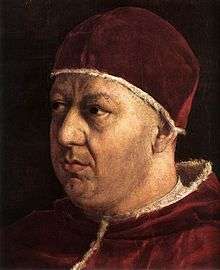 |
Leo X LEO Decimus |
Giovanni di Lorenzo de' Medici | 11 December 1475 Florence, Republic of Florence | 37 / 45 | Italian. Son of Lorenzo the Magnificent. Closed the Fifth Council of the Lateran. Remembered for granting indulgences to those who donated to rebuild St. Peter's Basilica; excommunicated Martin Luther (1521). Extended the Spanish Inquisition into Portugal. |
| 218 |
9 January 1522 – 14 September 1523 (1 year, 248 days) |
 |
Adrian VI HADRIANVS Sextus |
Adriaan Floriszoon Boeyens | 2 March 1459 Utrecht, Bishopric of Utrecht, Holy Roman Empire (now Netherlands) | 62 / 64 | Motto: Patere et sustine ("Respect and wait")[21]
The only Dutch pope; last non-Italian to be elected pope until John Paul II in 1978. Tutor of Emperor Charles V. |
| 219 |
26 November 1523 – 25 September 1534 (10 years, 303 days) |
_-_Pope_Clement_VII_-_Google_Art_Project.jpg) |
Clement VII CLEMENS Septimus |
Giulio di Giuliano de' Medici | 26 May 1478 Florence, Republic of Florence | 45 / 56 | Motto: Candor illæsus ("Unharmed candor")[22]
Italian; Cousin of Leo X. Rome plundered by imperial troops (1527). Forbade the divorce of Henry VIII; crowned Charles V as emperor at Bologna (1530). His niece was married to the future Henry II of France. Ordered Michelangelo's painting of The Last Judgment in the Sistine Chapel. |
| 220 |
13 October 1534 – 10 November 1549 (15 years, 28 days) |
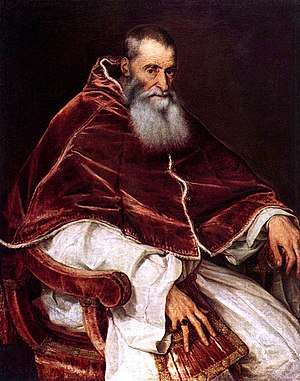 |
Paul III PAVLVS Tertius |
Alessandro Farnese | 29 February 1468 Canino, Lazio, Papal States | 66 / 81 | Italian. Opened the Council of Trent (1545). His illegitimate son became the first duke of Parma. Decreed the second and final excommunication of King Henry VIII of England. Appointed Michelangelo to supervise construction of St. Peter's Basilica (1546). Recognized the Order of the Society of Jesus (Jesuits). |
| 221 |
7 February 1550 – 29 March 1555 (5 years, 50 days) |
 |
Julius III IVLIVS Tertius |
Giovanni Maria Ciocchi del Monte | 10 September 1487 Rome, Lazio, Papal States | 62 / 67 | Italian. Established the Collegium Germanicum (1552). Reconvened the Council of Trent. The Innocenzo Scandal. |
| 222 |
9 April 1555 – 1 May 1555 (22 days) |
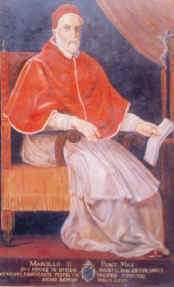 |
Marcellus II MARCELLVS Secundus |
Marcello Cervini degli Spannochi | 6 May 1501 Montefano, Marche, Papal States | 53 / 53 | Italian. The last to use his birth name as the regnal name. Instituted immediate economies in Vatican expenditures. The Missa Papae Marcelli composed in his honour. |
| 223 |
23 May 1555 – 18 August 1559 (4 years, 87 days) |
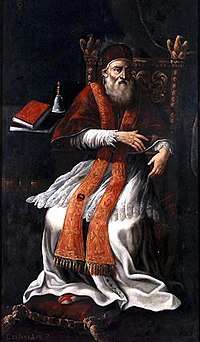 |
Paul IV PAVLVS Quartus |
Giovanni Pietro Carafa, C.R. | 28 June 1476 Capriglia Irpina, Campania, Kingdom of Naples | 78 / 83 | Motto: Dominus mihi adjutor ("The Lord is my helper")[23]
Italian. Member of the Theatines. Established the Roman Ghetto in Cum Nimis Absurdum (1555) and established the Index of Forbidden Books. Ordered Michelangelo to repaint the nudes of The Last Judgment modestly. |
| 224 |
26 December 1559 – 9 December 1565 (5 years, 348 days) |
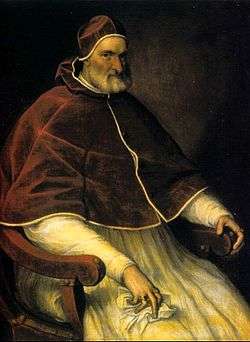 |
Pius IV PIVS Quartus |
Giovanni Angelo Medici | 31 March 1499 Milan, Duchy of Milan | 60 / 66 | Italian. Reopened and closed the Council of Trent. Ordered public construction to improve the water supply of Rome. Instituted the Tridentine Creed. |
| 225 |
7 January 1566 – 1 May 1572 (6 years, 115 days) |
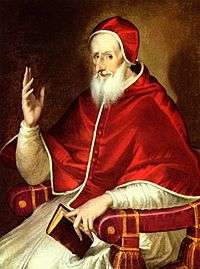 |
St Pius V PIVS Quintus |
Antonio Ghislieri, O.P. | 17 January 1504 Bosco, Piedmont, Duchy of Milan | 61 / 68 | Motto: Utinam dirigantur viæ meæ ad custodiendas ("It binds us to keep")[24]
Italian. Member of the Dominican Order. Excommunicated Queen Elizabeth I of England (1570). Battle of Lepanto (1571); instituted the feast of Our Lady of Victory. Issued the 1570 Roman Missal. |
| 226 |
13 May 1572 – 10 April 1585 (12 years, 332 days) |
 |
Gregory XIII GREGORIVS Tertius Decimus |
Ugo Boncompagni | 7 January 1502 Bologna, Emilia-Romagna, Papal States | 70 / 83 | Motto: Aperuit et clausit ("Opened and closed")[25]
Italian. Reformed the calendar (1582); built the Gregorian Chapel in the Vatican. The first pope to bestow the Immaculate Conception as patroness to the Philippine Islands through the bull Ilius Fulti Præsido (1579). Strengthened diplomatic ties with Asian nations. |
| 227 |
24 April 1585 – 27 August 1590 (5 years, 125 days) |
Sixtus V XYSTVS Quintus |
Felice Peretti di Montalto, O.F.M. Conv. | 13 December 1521 Grottammare, Marche, Papal States | 63 / 68 | Italian. Member of the Conventual Franciscan Order. Known for fixing and completing building works to major basilicas in Rome. Limited the College of Cardinals to 70 in number; doubled the number of curial congregations. | |
| 228 |
15 September 1590 – 27 September 1590 (12 days) |
 |
Urban VII VRBANVS Septimus |
Giovanni Battista Castagna | 4 August 1521 Rome, Lazio, Papal States | 69 / 69 | Italian; Supported by the Spanish. Shortest-reigning pope; died before coronation. Set the first known worldwide smoking ban, banning smoking in and near all churches. |
| 229 |
5 December 1590 – 16 October 1591 (315 days) |
 |
Gregory XIV GREGORIVS Quartus Decimus |
Niccolò Sfondrati | 11 February 1535 Somma Lombardo, Lombardy, Duchy of Milan | 55 / 56 | Italian. Modified the constitution Effraenatam of Sixtus V so that the penalty for abortion did not apply until the foetus became animated (1591). Made gambling on papal elections punishable by excommunication. |
| 230 |
29 October 1591 – 30 December 1591 (62 days) |
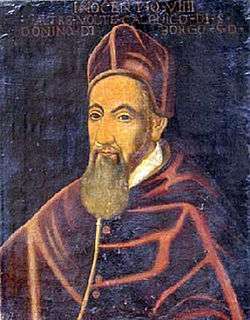 |
Innocent IX INNOCENTIVS Nonus |
Giovanni Antonio Facchinetti | 20 July 1519 Bologna, Emilia-Romagna, Papal States | 72 / 72 | Italian. Supported the cause of King Philip II of Spain and the Catholic League against King Henry IV of France in the French Wars of Religion. Prohibited the alienation of church property. |
| 231 |
30 January 1592 – 3 March 1605 (13 years, 32 days) |
 |
Clement VIII CLEMENS Octavus |
Ippolito Aldobrandini | 24 February 1536 Fano, Marche, Papal States | 55 / 69 | Italian. Initiated an alliance of European Christian powers to partake in the war with the Ottoman Empire known as The Long War (1595). Convened the Congregatio de Auxiliis which addressed doctrinal disputes between the Dominicans and Jesuits regarding free will and divine grace.[26] |
17th century
| Pontiff number |
Pontificate | Portrait | Name: English · Latin |
Personal name | Place of birth | Age at start/ end of papacy |
Notes |
|---|---|---|---|---|---|---|---|
| 232 |
1 April 1605 – 27 April 1605 (26 days) |
 |
Leo XI LEO Undecimus |
Alessandro Ottaviano de' Medici | 2 June 1535 Florence, Duchy of Florence | 69 / 69 | Italian. The nephew of Leo X. Called "Papa Lampo" (Lightning Pope) for his brief pontificate. |
| 233 |
16 May 1605 – 28 January 1621 (15 years, 257 days) |
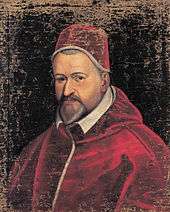 |
Paul V PAVLVS Quintus |
Camillo Borghese | 17 September 1550 Rome, Lazio, Papal States | 52 / 68 | Motto: Absit nisi in te gloriari ("May it be absent, except to glory in you")[27]
Italian. Known for various building projects which included the facade of St Peter's Basilica. Established the Bank of the Holy Spirit (1605); restored the Aqua Traiana. |
| 234 |
9 February 1621 – 8 July 1623 (2 years, 149 days) |
 |
Gregory XV GREGORIVS Quintus Decimus |
Alessandro Ludovisi | 9 January 1554 Bologna, Emilia-Romagna, Papal States | 67 / 69 | Italian. Established the Congregation for the Propagation of the Faith (1622). Issued the bull Aeterni Patris (1621) which imposed conclaves to be by secret ballot. Issued the constitution Omnipotentis Dei against magicians and witches (1623). |
| 235 |
6 August 1623 – 29 July 1644 (20 years, 358 days) |
 |
Urban VIII VRBANVS Octavus |
Maffeo Barberini | 5 April 1568 Florence, Grand Duchy of Tuscany | 55 / 76 | Italian. Trial against Galileo Galilei. The last pope to expand papal territory by force of arms. Issued a 1624 bill that made the use of tobacco in holy places punishable by excommunication. |
| 236 |
15 September 1644 – 7 January 1655 (10 years, 114 days) |
 |
Innocent X INNOCENTIVS Decimus |
Giovanni Battista Pamphilj | 6 May 1574 Rome, Lazio, Papal States | 70 / 80 | Motto: Alleviatæ sunt aquæ super terram ("Water on earth")[28]
Italian. The great-great-great-grandson of Alexander VI. Erected the Fontana dei Quattro Fiumi in Piazza Navona. Promulgated the apostolic constitution Cum occasione (1653) which condemned five doctrines of Jansenism as heresy. |
| 237 |
7 April 1655 – 22 May 1667 (12 years, 45 days) |
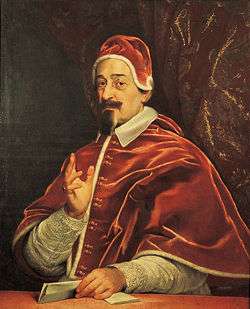 |
Alexander VII ALEXANDER Septimus |
Fabio Chigi | 13 February 1599 Siena, Grand Duchy of Tuscany | 56 / 68 | Italian. Great-nephew of Paul V. Commissioned St. Peter's Square. Issued the constitution Sollicitudo Omnium Ecclesiarum that set the doctrine of the Immaculate Conception almost identical to that of Pius IX centuries later. |
| 238 |
20 June 1667 – 9 December 1669 (2 years, 172 days) |
 |
Clement IX CLEMENS Nonus |
Giulio Rospigliosi | 28 January 1600 Pistoia, Grand Duchy of Tuscany | 67 / 69 | Motto: Aliis non sibi Clemens ("Clement to others, not to himself")[29]
Italian. Mediated in the peace of Aachen (1668). |
| 239 |
29 April 1670 – 22 July 1676 (6 years, 84 days) |
_Gaulli)_-_Nationalmuseum_-_19080.tif.jpg) |
Clement X CLEMENS Decimus |
Emilio Bonaventura Altieri | 13 July 1590 Rome, Lazio, Papal States | 79 / 86 | Motto: Bonum auget malum minuit ("He increases good and diminishes evil")[30]
Italian. Canonized the first saint from the Americas: St. Rose of Lima (1671). Decorated the bridge of Sant' Angelo with the ten statues of angels and added one of the two fountains that adorn the piazza of St. Peter's. Established regulations for the removal of relics of saints from cemeteries. |
| 240 |
21 September 1676 – 12 August 1689 (12 years, 325 days) |
 |
Bl. Innocent XI INNOCENTIVS Undecimus |
Benedetto Odescalchi | 16 May 1611 Como, Lombardy, Duchy of Milan | 65 / 78 | Motto: Avarus non Implebitur ("The covetous man is not satisfied")[31]
Italian. Condemned the doctrine of mental reservation (1679) and initiated the Holy League. Extended the Holy Name of Mary as a universal feast (1684). Admired for positive contributions to catechesis. |
| 241 |
6 October 1689 – 1 February 1691 (1 year, 118 days) |
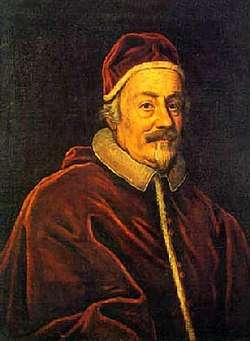 |
Alexander VIII ALEXANDER Octavus |
Pietro Vito Ottoboni | 22 April 1610 Venice, Republic of Venice | 79 / 80 | Italian. Condemned the so-called philosophical sin (1690). |
| 242 |
12 July 1691 – 27 September 1700 (9 years, 77 days) |
Innocent XII INNOCENTIVS Duodecimus |
Antonio Pignatelli, O.F.S | 13 March 1615 Spinazzola, Apulia, Kingdom of Naples | 76 / 85 | Italian. Issued the bull Romanum decet Pontificem to stop nepotism (1692). Erected various charitable and educational institutions. |
18th century
| Pontiff number |
Pontificate | Portrait | Name: English · Latin |
Personal name | Place of birth | Age at start/ end of papacy |
Notes |
|---|---|---|---|---|---|---|---|
| 243 |
23 November 1700 – 19 March 1721 (20 years, 116 days) |
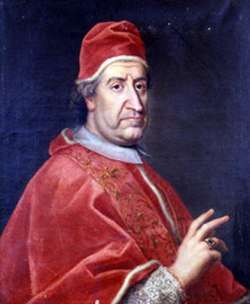 |
Clement XI CLEMENS Undecimus |
Giovanni Francesco Albani | 23 July 1649 Urbino, Marche, Papal States | 51 / 71 | Italian. The Chinese Rites controversy. Patronized the first archaeological excavations in the Roman catacombs and made the feast of the Immaculate Conception universal.[12] |
| 244 |
8 May 1721 – 7 March 1724 (2 years, 304 days) |
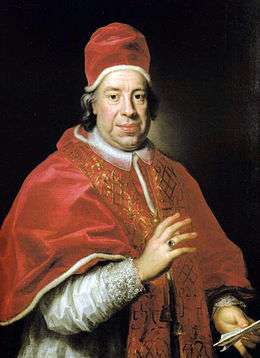 |
Innocent XIII INNOCENTIVS Tertius Decimus |
Michelangelo dei Conti | 13 May 1655 Poli, Lazio, Papal States | 65 / 68 | Italian. Prohibited the Jesuits from prosecuting their mission in China ordering that no new members should be received into the order. Issued the papal bull Apostolici Ministerii (1724) to revive ecclesiastical discipline in Spain. |
| 245 |
29 May 1724 – 21 February 1730 (5 years, 268 days) |
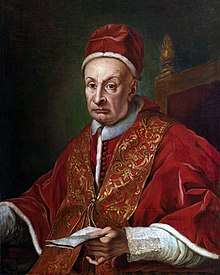 |
S.D. Benedict XIII BENEDICTVS Tertius Decimus |
Pietro Francesco Orsini, O.P. | 2 February 1649 Gravina in Puglia, Bari, Kingdom of Naples | 75 / 81 | Italian. Member of the Dominican Order; third and last member of the Orsini family to be pope. Originally called Benedict XIV due to the antipope but reverted to XIII. Repealed the worldwide tobacco smoking ban set by Urban VII and Urban VIII. |
| 246 |
12 July 1730 – 6 February 1740 (9 years, 209 days) |
 |
Clement XII CLEMENS Duodecimus |
Lorenzo Corsini, O.F.S | 7 April 1652 Florence, Grand Duchy of Tuscany | 78 / 87 | Motto: Dabis discernere inter malum et bonum ("You shall deign to distinguish between good and evil")[32]
Italian. Completed the new façade of the Archbasilica of Saint John Lateran (1735). Commissioned the Trevi Fountain in Rome (1732). Condemned Freemasonry in In eminenti apostolatus (1738). |
| 247 |
17 August 1740 – 3 May 1758 (17 years, 259 days) |
 |
Benedict XIV BENEDICTVS Quartus Decimus |
Prospero Lorenzo Lambertini | 31 March 1675 Bologna, Papal States | 65 / 83 | Motto: Curabuntur omnes ("All will be healed")[33]
Italian. Reformed the education of priests and the calendar of feasts. Completed the Trevi Fountain and affirmed the teachings of Thomas Aquinas; founded academies of art, religion and science. |
| 248 |
6 July 1758 – 2 February 1769 (10 years, 211 days) |
 |
Clement XIII CLEMENS Tertius Decimus |
Carlo della Torre di Rezzonico | 7 March 1693 Venice, Republic of Venice | 65 / 75 | Italian. Provided the famous fig leaves on nude male statues in the Vatican. Defended the Society of Jesus in "Apostolicum pascendi" (1765). |
| 249 |
19 May 1769 – 22 September 1774 (5 years, 126 days) |
 |
Clement XIV CLEMENS Quartus Decimus |
Giovanni Vincenzo Antonio Ganganelli, O.F.M. Conv. | 31 October 1705 Sant' Arcangelo di Romagna, Papal States |
63 / 68 | Italian. Member of the Conventual Franciscan Order. Suppressed the Society of Jesus in the brief "Dominus ac Redemptor" (1773). |
| 250 |
15 February 1775 – 29 August 1799 (24 years, 195 days) |
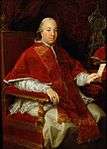 |
Pius VI PIVS Sextus |
Count Giovanni Angelo Braschi | 25 December 1717 Cesena, Emilia-Romagna, Papal States | 57 / 81 | Motto: Floret in domo domini ("It blossoms in the house of God")[34]
Italian. Condemned the French Revolution; expelled from the Papal States by French troops from 1798 until his death. The last pope to be a patron of Renaissance art. |
| — | 29 August 1799 – 14 March 1800 (197 days) (197) |
 |
Interregnum | Six-month period without a valid pope elected. This was due to unique logistical problems (the old pope died a prisoner and the conclave was in Venice) and a deadlock among cardinals voting. | |||
19th century
| Pontiff number |
Pontificate | Portrait | Name: English · Latin |
Personal name | Place of birth | Age at start/ end of papacy |
Notes |
|---|---|---|---|---|---|---|---|
| 251 |
14 March 1800 – 20 August 1823 (23 years, 159 days) |
 |
S.D. Pius VII PIVS Septimus |
Count Barnaba Niccolò Maria Luigi Chiaramonti, O.S.B. | 14 August 1742 Cesena, Emilia-Romagna, Papal States | 57 / 81 | Italian. Member of the Order of Saint Benedict. Present at Napoleon's coronation as emperor of the French. Expelled from the Papal States by the French between 1809 and 1814. |
| 252 |
28 September 1823 – 10 February 1829 (5 years, 135 days) |
Leo XII LEO Duodecimus |
Count Annibale Francesco Clemente Melchiore Girolamo Nicola Sermattei della Genga | 22 August 1760 Genga, Marche, Papal States | 63 / 68 | Italian. Placed the Catholic educational system under the control of the Jesuits through Quod divina sapientia (1824). Condemned the Bible societies. | |
| 253 |
31 March 1829 – 30 November 1830 (1 year, 244 days) |
Pius VIII PIVS Octavus |
Francesco Saverio Castiglioni | 20 November 1761 Cingoli, Marche, Papal States | 67 / 69 | Italian. Accepted Louis Philippe I as king of the French. Condemned the masonic secret societies and modernist biblical translations in the brief Litteris altero (1830). | |
| 254 |
2 February 1831 – 1 June 1846 (15 years, 119 days) |
 |
Gregory XVI GREGORIVS Sextus Decimus |
Bartolomeo Alberto Cappellari, O.S.B. Cam. | 18 September 1765 Belluno, Veneto, Republic of Venice | 65 / 80 | Italian. Member of the Camaldolese; last non-bishop to be elected to the papacy. Opposed democratic and modernising reforms in the Papal States. |
| 255 |
16 June 1846 – 7 February 1878 (31 years, 236 days) (11559) |
 |
Bl. Pius IX PIVS Nonus |
Count Giovanni Maria Mastai-Ferretti, O.F.S. | 13 May 1792 Senigallia, Marche, Papal States | 54 / 85 | Italian. Opened the First Vatican Council; lost the Papal States to Italy. Defined the dogma of the Immaculate Conception and defined papal infallibility. Issued the controversial Syllabus of Errors. Longest-serving pope since Peter (c. AD 30–64). |
| 256 |
20 February 1878 – 20 July 1903 (25 years, 150 days) |
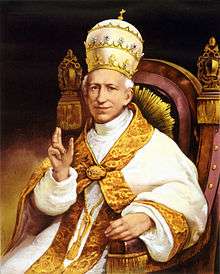 |
Leo XIII LEO Tertius Decimus |
Gioacchino Vincenzo Raffaele Luigi Pecci, O.F.S. | 2 March 1810 Carpineto Romano, Lazio, French Empire | 67 / 93 | Italian. Issued the encyclical Rerum novarum; supported Christian democracy against Communism. Had the third-longest reign after Pius IX, and John Paul II. Promoted the rosary and the scapular and approved two new Marian scapulars; first pope to fully embrace the concept of Mary as mediatrix. |
20th century
| Pontiff number |
Pontificate | Portrait | Name: English · Latin |
Personal name | Place of birth | Age at start/ end of papacy |
Notes |
|---|---|---|---|---|---|---|---|
| 257 |
4 August 1903 – 20 August 1914 (11 years, 16 days) |
 |
St Pius X PIVS Decimus |
Giuseppe Melchiorre Sarto, O.F.S. | 2 June 1835 Riese, Treviso, Kingdom of Lombardy–Venetia | 68 / 79 | Motto: Instaurare Omnia in Christo ("Restore all things in Christ")
Italian. Encouraged and expanded reception of the Eucharist. Combatted Modernism; issued the oath against it. Advocated the Gregorian Chant and reformed the Roman Breviary. |
| 258 |
3 September 1914 – 22 January 1922 (7 years, 141 days) |
 |
Benedict XV BENEDICTVS Quintus Decimus |
Giacomo Paolo Giovanni Battista Della Chiesa, O.F.S. | 21 November 1854 Pegli, Genoa, Kingdom of Sardinia | 59 / 67 | Motto: In te, Domine, speravi: non confundar in aeternum. ("In thee, o Lord, have I trusted: let me not be confounded for evermore.")
Italian. Credited for intervening for peace during World War I. Issued the 1917 Code of Canon Law; supported the missionaries in Maximum illud. Remembered by Benedict XVI as a "prophet of peace". |
| 259 |
6 February 1922 – 10 February 1939 (17 years, 4 days) (6213) |
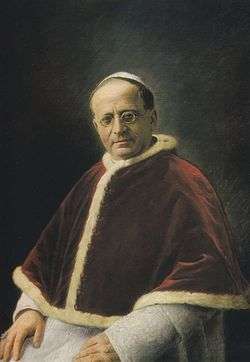 |
Pius XI PIVS Undecimus |
Achille Ambrogio Damiano Ratti, O.F.S. | 31 May 1857 Desio, Milan, Kingdom of Lombardy–Venetia | 64 / 81 | Motto: Pax Christi in Regno Christi ("The Peace of Christ in the Kingdom of Christ")
Italian. Signed the Lateran Treaty with Italy (1929) establishing Vatican City as a sovereign state. Inaugurated Vatican Radio (1931). Re-founded the Pontifical Academy of Sciences (1936). Created the feast of Christ the King. Opposed Communism and Nazism. |
| 260 |
2 March 1939 – 9 October 1958 (19 years, 221 days) |
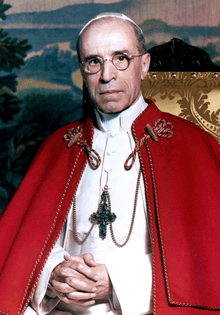 |
Ven. Pius XII PIVS Duodecimus |
Eugenio Maria Giuseppe Giovanni Pacelli, O.F.S. | 2 March 1876 Rome, Italy | 63 / 82 | Motto: Opus Justitiae Pax ("The work of justice [shall be] peace")
Italian. Invoked papal infallibility in the encyclical Munificentissimus Deus; defined the dogma of the Assumption. Eliminated the Italian majority of cardinals. Credited with intervening for peace during World War II; controversial for his reactions to the Holocaust. |
| 261 |
28 October 1958 – 3 June 1963 (4 years, 218 days) |
 |
St John XXIII IOANNES Vicesimus Tertius |
Angelo Giuseppe Roncalli, O.F.S. | 25 November 1881 Sotto il Monte, Bergamo, Italy | 76 / 81 | Motto: Obedientia et Pax ("Obedience and peace")
Italian. Opened the Second Vatican Council; called "Good Pope John". Issued the encyclical Pacem in terris (1963) on peace and nuclear disarmament; intervened for peace during the Cuban Missile Crisis (1962). |
| 262 |
21 June 1963 – 6 August 1978 (15 years, 46 days) |
 |
St Paul VI PAVLVS Sextus |
Giovanni Battista Enrico Antonio Maria Montini | 26 September 1897 Concesio, Brescia, Italy | 65 / 80 | Motto: Cum Ipso in Monte ("With Him on the mount")
Italian. Last pope to be crowned. First pope since 1809 to travel outside Italy. Closed the Second Vatican Council. Issued the encyclical Humanae vitae (1968) condemning artificial contraception. Revised the Roman Missal (1969). |
| 263 |
26 August 1978 – 28 September 1978 (33 days) |
.jpg) |
Ven. John Paul I IOANNES PAVLVS Primus |
Albino Luciani | 17 October 1912 Forno di Canale, Belluno, Italy | 65 / 65 | Motto: Humilitas ("Humility")
Italian. Abolished the coronation and opted for the papal inauguration. First pope to use 'the First' in papal name; first with two names for two immediate predecessors. Last pope to use the sedia gestatoria. |
| 264 |
16 October 1978 – 2 April 2005 (26 years, 168 days) |
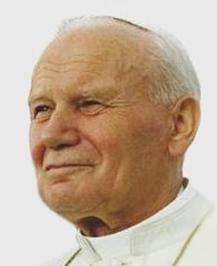 |
St John Paul II IOANNES PAVLVS Secundus |
Karol Józef Wojtyła | 20 May 1920 Wadowice, Poland | 58 / 84 | Motto: Totus Tuus ("Totally yours")
Polish, first pope of Slavic origin. First non-Italian pope since Adrian VI (1522–1523). Travelled extensively, visiting 129 countries during his pontificate. Second longest reign after Pius IX. Founded World Youth Day (1984) and the Pontifical Academy of Social Sciences (1994). Canonized more saints than all his predecessors. Youngest individual to start his papacy since Pius IX (1846). |
3rd millennium
21st century
| Pontiff number |
Pontificate | Portrait | Name: English · Latin |
Personal name | Place of birth | Age at start/ end of papacy |
Notes |
|---|---|---|---|---|---|---|---|
| 265 |
19 April 2005 – 28 February 2013 (7 years, 315 days) |
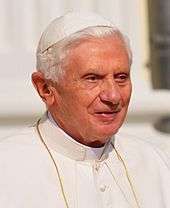 |
Benedict XVI BENEDICTVS Decimus Sextus |
Joseph Aloisius Ratzinger | 16 April 1927 Marktl am Inn, Bavaria, Germany | 78 / 85 | Motto: Cooperatores Veritatis ("Cooperators of the truth")
German. Still alive. Oldest to become pope since Clement XII (1730). Elevated the Tridentine Mass to a more prominent position and promoted the use of Latin; re-introduced several disused papal garments. Established the Anglican Ordinariate (2009). First pope to renounce the papacy on his own initiative since Celestine V (1294),[35] becoming pope emeritus.[36] |
| 266 |
13 March 2013 – present (7 years, 156 days) |
 |
Francis FRANCISCVS |
Jorge Mario Bergoglio, S.J. | 17 December 1936 Flores, Buenos Aires, Argentina | 76 | Motto: Miserando atque Eligendo ("Lowly but chosen", literally 'by having mercy, by choosing him')[37]
Argentinian. First pope to be born outside Europe since Gregory III (731–741) and the first from the Americas; first pope from the Southern Hemisphere. First pope from a religious institute since Gregory XVI (1831–1846); first Jesuit pope. First to use a new and non-composed regnal name since Lando (913–914). First pope to visit and hold papal mass in the Arabian Peninsula. |
Notes
- Now Bethsaida, Galilee, Israel.
- Now Volterra, Italy.
- Now Athens, Greece.
- Now Rome, Italy.
- Now Bethlehem, Israel.
- Now Aquileia, Italy.
- Now Homs, Syria.
- Nicopolis is now a Roman ruin near the city of Preveza, Greece.
- It is not clear when Pope Victor I was born, and where he was born, although some[7] suggest he was born in Leptis Magna, now a part of Libya.
Religious orders
51 popes and 6 antipopes (in italics) have been members of religious orders, including 12 members of third orders. They are listed by order as follows:
Numbering of popes
Regnal numbers follow the usual convention for European monarchs. Popes with unique names are not identified by ordinals. Antipopes are treated as pretenders, and their numbers are reused by those considered to be legitimate popes. However, there are anomalies in the numbering of the popes. Several numbers were mistakenly increased in the Middle Ages because the records were misunderstood. Several antipopes were also kept in the sequence, either by mistake or because they were previously considered to be true popes.
- Alexander: Antipope Alexander V (1409–1410) was listed in the Annuario Pontificio as a legitimate pope until the 20th century,[38] when the Pisan popes were reclassified as antipopes. There had already been three more Alexanders by then, so there is now a gap in the numbering sequence.
- Donus: The name has only been used by one pope. The apocryphal Pope Donus II resulted from confusion between the Latin word dominus (lord) and the name Donus.
- Felix: Antipope Felix II (356–357) was kept in the numbering sequence.[39]
- John: The numbering of the Johns is particularly confused. In the modern sequence, the Johns are identified by the numbers they used during their reigns.
- Antipope John XVI (997–998) was kept in the numbering sequence.
- Pope John XXI (1276–1277) chose to skip the number XX, believing that there had been another John between XIV and XV. In reality, John XIV had been counted twice.[40]
- By the 16th century, the numbering error had been conflated with legends about a female Pope Joan, whom some authors called John VIII. She was never listed in the Annuario Pontificio.[41]
- Antipope John XXIII (1410–1415) was listed in the Annuario Pontificio as a legitimate pope until the 20th century.[38] John XXIII became an antipope when Pope John XXIII (1958–1963) chose to reuse the number, citing "twenty-two [sic] Johns of indisputable legitimacy."[42]
- Martin: Pope Martin I (649–655) is followed by Martin IV (1281–1285). Due to the similarity between the Latin names Marinus and Martinus, Marinus I and Marinus II were mistakenly considered to be Martin II and III.[43]
- Stephen: Pope-elect Stephen (752) died before being consecrated. He was previously known as Stephen II, but the Vatican removed him from the official list of popes in 1961.[40] The remaining Stephens are now numbered Pope Stephen II (752–757) to Pope Stephen IX (1057–1058).
Those who adhere to sedevacantism say that there have been no legitimate popes since Pius XII or John XXIII. This is because they consider all popes since the Second Vatican Council to be heretics.[44][45]
See also
Lists
|
Related topics
|
References
Specific
- Annuario Pontificio 2012 (Libreria Editrice Vaticana 2012 ISBN 978-88-209-8722-0), p. 12*
- "Corrections Made to Official List of Popes". ZENIT. 5 June 2001. Archived from the original on 19 January 2009. Retrieved 21 October 2008.
- "Papal Primacy of honour: titles and insignia". Newadvent.org. 1 June 1911. Retrieved 23 February 2013.
- Fahlbusch, Erwin; et al., eds. (2005). "Pope, Papacy". Evangelisches Kirchenlexikon [The encyclopedia of Christianity]. 4. Translated by Bromiley, Geoffrey William. Wm. B. Eerdmans Publishing. pp. 272–282. ISBN 978-0-8028-2416-5. Retrieved 7 September 2011.
- Against Heresies 3:3.3
- The fourth pope Discussed in the article on Clement I
- Fisher, Max (13 March 2013). "WorldViews Sorry, Jorge Mario Bergoglio is not the first non-European pope". The Washington Post. Retrieved 24 November 2017.
- Mcbrien, Richard P. (31 October 2006). The Pocket Guide to the Popes. HarperCollins. pp. 30–31. ISBN 978-0-06-113773-0. Retrieved 6 March 2012.
- "The Chronography of 354 AD. Part 13: Bishops of Rome". pp. from Theosodr Mommsen, MGH Chronica Minora I (1892), pp.73–6. Retrieved 6 March 2012.
- "OCA – St Liberius the Pope of Rome". Ocafs.oca.org. Retrieved 23 February 2013.
- "Saint Siricius".
- "Papal Timeline". 2005. Archived from the original on 20 July 2014. Retrieved 3 August 2014.
- Deno John Geanakoplos (15 September 1989). Constantinople and the West: essays on the late Byzantine (Palaeologan) and Italian Renaissances and the Byzantine and Roman churches. Univ of Wisconsin Press. pp. 263–. ISBN 978-0-299-11884-6. Retrieved 3 March 2012.
- "Blessed Eugene III". Retrieved 9 July 2015.
- For the dates of death of Clement III and the election of Celestine III see Katrin Baaken: Zu Wahl, Weihe und Krönung Papst Cölestins III. Deutsches Archiv für Erforschung des Mittelalters Volume 41 / 1985, pp. 203–211
- Philip Hughes, "Innocent III & the Latin East," History of the Church, vol. 2, p. 371, Sheed & Ward, 1948.
- https://www.britannica.com/biography/Clement-VIII-antipope
- https://books.google.pl/books?id=JlExDwAAQBAJ&pg=PT588#v=onepage&q&f=false
- https://www.britannica.com/biography/Amadeus-VIII
- https://www.britannica.com/biography/Nicholas-V-pope
- "Pope Adrian VI (1522–1523)". GCatholic. Retrieved 1 April 2014.
- "Pope Clement VII (1523–1534)". GCatholic. Retrieved 1 April 2014.
- "Pope Paul IV (1555–1559)". GCatholic. Retrieved 1 April 2014.
- "Pope Pius V (1566–1572)". GCatholic. Retrieved 1 April 2014.
- "Pope Gregory XIII (1572–1585)". Retrieved 3 August 2014.
- John Henry Blunt (1874). "Jansenists". Dictionary of Sects, Heresies, Ecclesiastical Parties, and Schools of Religious Thought. Rivingtons. pp. 234–240. Retrieved 11 August 2012.
- "Pope Alexander VII (1655–1667)". GCatholic. Retrieved 1 April 2014.
- "Pope Innocent X (1644–1655)". Retrieved 3 August 2014.
- "Pope Clement IX (1667–1669)". Retrieved 3 August 2014.
- "Pope Clement X (1670–1676)". Retrieved 3 August 2014.
- "Pope Innocent XI (1676–1689)". Retrieved 3 August 2014.
- "Pope Clement XII (1730–1740)". GCatholic. Retrieved 14 August 2014.
- "Pope Benedict XIV (1740–1758)". GCatholic. Retrieved 14 August 2014.
- "The Wind was too Strong". Rome Art Lover. Retrieved 12 February 2014.
- Brown, Andrew (11 February 2013). "Benedict, the placeholder pope who leaves a battered, weakened church". The Guardian. Retrieved 12 February 2013.
- Pianigiani, Gaia; Povoledo, Elisabetta (27 February 2013). "Benedict XVI to Keep His Name and Become Pope Emeritus". The New York Times.
- Scarisbrick, Veronica (22 March 2013). "Pope Francis : "Miserando atque eligendo"..." Vatican Radio. The Holy See. Vatican Radio. Retrieved 10 May 2015.
- Annuario pontificio per l'anno 1942. Rome. 1942. p. 21.
205. Gregorio XII, Veneto, Correr (c. 1406, cessò a. 1409, m. 1417) - Pont. a. 2, m. 6. g. 4. 206. Alessandro V, dell'Isola di Candia, Filargo (c. 1409, m. 1410). - Pont. m. 10, g. 8. 207. Giovanni XXII o XXIII o XXIV, Napoletano, Cossa (c. 1410, cessò dal pontificare 29 mag. 1415
- Paschal Robinson (1913). . In Herbermann, Charles (ed.). Catholic Encyclopedia. New York: Robert Appleton Company.
- Paschal Robinson (1913). . In Herbermann, Charles (ed.). Catholic Encyclopedia. New York: Robert Appleton Company.
- Paschal Robinson (1913). . In Herbermann, Charles (ed.). Catholic Encyclopedia. New York: Robert Appleton Company.
- "I Choose John ..." Time. 10 November 1958. p. 91.
- Paschal Robinson (1913). . In Herbermann, Charles (ed.). Catholic Encyclopedia. New York: Robert Appleton Company.
- Weaver, MJ., and Appleby, RS., Being Right: Conservative Catholics in America, Indiana University Press, 1 January 1995, p. 257.
- Flinn, FK., Encyclopedia of Catholicism, 2007, p. 566.
General
- The Early Papacy: To the Synod of Chalcedon in 451, Adrian Fortescue, Ignatius Press, 2008.
- The Oxford Dictionary of Popes, John N.D. Kelly, Oxford University Press, 1986.
- Catholicism, Henri de Lubac, Ignatius Press, 1988.
- Rome and the Eastern Churches, Aidan Nichols, Ignatius Press, 2010.
- I Papi. Venti secoli di storia, Pontificia Amministrazione della Patriarcale Basilica di San Paolo, Libreria Editrice Vaticana, 2002.
- Rome Sweet Home, Scott Hahn, Ignatius Press, 1993.
- Enciclopedia dei Papi, AA.VV., Istituto dell'Enciclopedia italiana, 2000.